A Complete Fukuoka Itinerary: The Best Things to Do in Fukuoka & Places to Eat in Fukuoka
Fukuoka is a city located in southern Japan in the Kyushu region and is one of my favorite cities in Japan! It has a population of approximately 1.5 million people, making it the most populous city in the Kyushu region and the 5th largest in Japan in government-designated cities. Though it is a dynamic metropolis, it lives up to its nickname of “a compact city” and has an incredibly welcoming feel.
Being that Fukuoka also has its own International Airport, it is extremely convenient to travel from other countries or domestically while in Japan. Naturally, it makes sense to add this Fukuoka itinerary if you are considering making a road trip around the Kyushu region or want to spend a few days in a city outside of the Golden Route!
The city has an impressive history of temples, shrines, festivals, flower parks, beaches, and of course, food – which is what Fukuoka is most known for. Fukuoka is famous for many dishes, including Hakata ramen, Mizutaki (a hot pot dish of chicken and vegetables), and some of the freshest seafood you’ll ever eat! When following this Fukuoka itinerary, prepare yourself for a feast!
Transportation in Fukuoka

Fukuoka by Public Transportation
Like most major cities in Japan, Fukuoka has several public transportation options to get you around the city. However, there are limited options for travel via JR trains in Fukuoka City so those utilizing the JR pass will need to be aware of alternative means of transportation such as public buses.
Nishitetsu: One of Japan’s “Big 16” private railway companies is Nishitetsu, it offers the largest coverage of public transportation in Fukuoka city. Nishitetsu local bus offers a large area of coverage in Fukuoka with numerous stops across the city. Nishitetsu also has a train service throughout Fukuoka City. Nishitetsu has a wide variety of transportation passes that you can explore here including the following.
- Fukuoka Tourist City Pass is a one-day transportation pass offering unlimited rides on buses, trains, subways, and ferries in Fukuoka. Additionally, it can be used to get discounts on many things to do in Fukuoka. For Fukuoka City, it is ¥2,500 for adults and 1,250 for children. For coverage in both Fukuoka City and Dazaifu, the pass is ¥2,800 for adults and ¥1,400 for children.
- A Nishitetsu one-day pass is also available for purchase for ¥1,200 for adults or ¥600 for children.
- A rechargeable IC card called Nimoca for use on public transportation, works similarly to the Suica and Pasmo cards found in Tokyo. Nimoca cards can also be used for purchasing certain goods at many retail locations or you can use another IC card such as Suica and Pasmo on your Apple or Google wallet.
Fukuoka by Car
The first time we visited Fukuoka we traveled around the Kyushu region by car we chose to spend our 2 days in Fukuoka traveling by rental car. It was easier to find public parking here than other cities in Japan but on other visits to Fukuoka, we have utilized public transport as it is still a very convenient way to see the city and you don’t have to worry about finding public parking and paying for parking fees.
Fukuoka by Taxi
Another easy way to visit different parts of Fukuoka is by calling a taxi. In the evening, when we didn’t have far to go, but still would be a long walk we utilized a taxi to take us to a few places that were within walking distance of one another. You can always try to find a taxi stand on Google Maps or ask someone, “
If you are leaving a restaurant or your hotel often you can ask one of the staff to call a taxi for you by simply saying “Takushi-
Where to Stay in Fukuoka
Hotel Il Palazzo
If you are looking for a hotel that is in a convenient location for your Fukuoka itinerary then the newly renovated Hotel Il Palazzo is perfect for your stay. If you are traveling to Fukuoka by car there is also parking at Hotel Il Palazzo which makes it easy to park your vehicle and walk around Fukuoka City or use public transit.
What we loved most about Hotel Il Palazzo other than having the ideal location, were the spacious rooms that contained many unique features. The rooms had numerous romantic touches for those traveling as a couple and had plenty of space to be family-friendly as well.
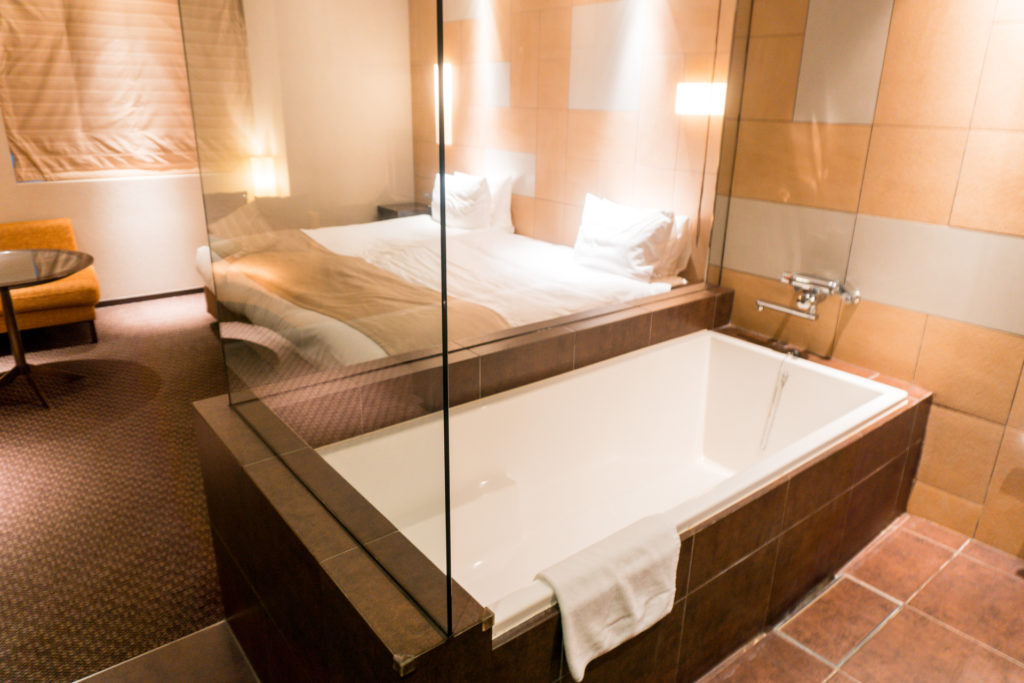

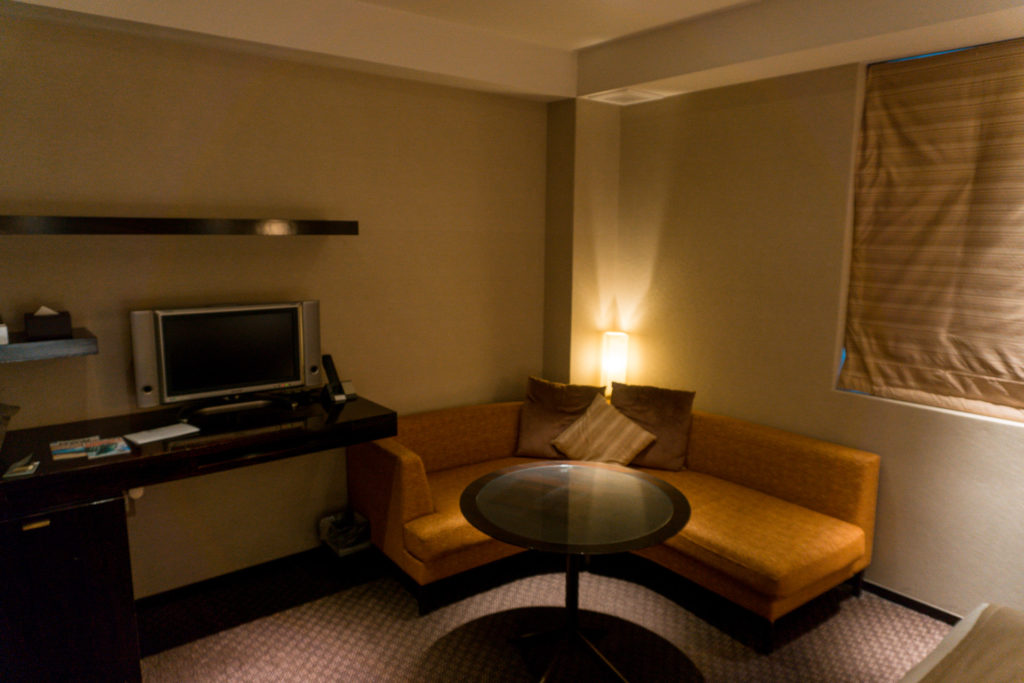
When you walk in you’ll immediately see a private bathroom followed by a stunning shower and bath area with glass all around you. In the closet area, we were impressed by the amount of storage space for our luggage and were able to unpack a few items to use during our stay.
On the other side of the closet is another sliding door but no it’s not more closet space! It’s actually where the room’s sink and amenities are held. We found this to be a nice touch to save space in the bathroom area and add more space to the rest of the room where the main feature of the room was the largest hotel bed we’ve ever seen!

In the mornings we highly recommend trying the Hotel Il Palazzo’s breakfast buffet, which has been internationally ranked as one of the best hotel breakfasts in Japan. There is a large variety to choose from including traditional Japanese dishes such as rice, miso soup, fish, and natto. But there are also Western breakfast items such as scrambled eggs and breakfast meats.
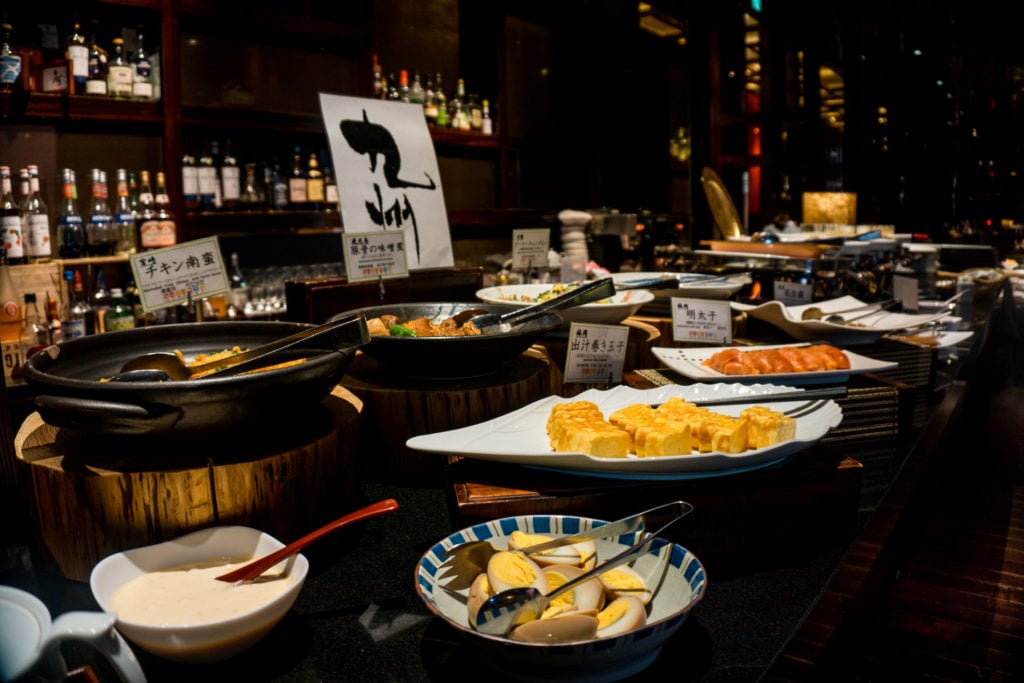

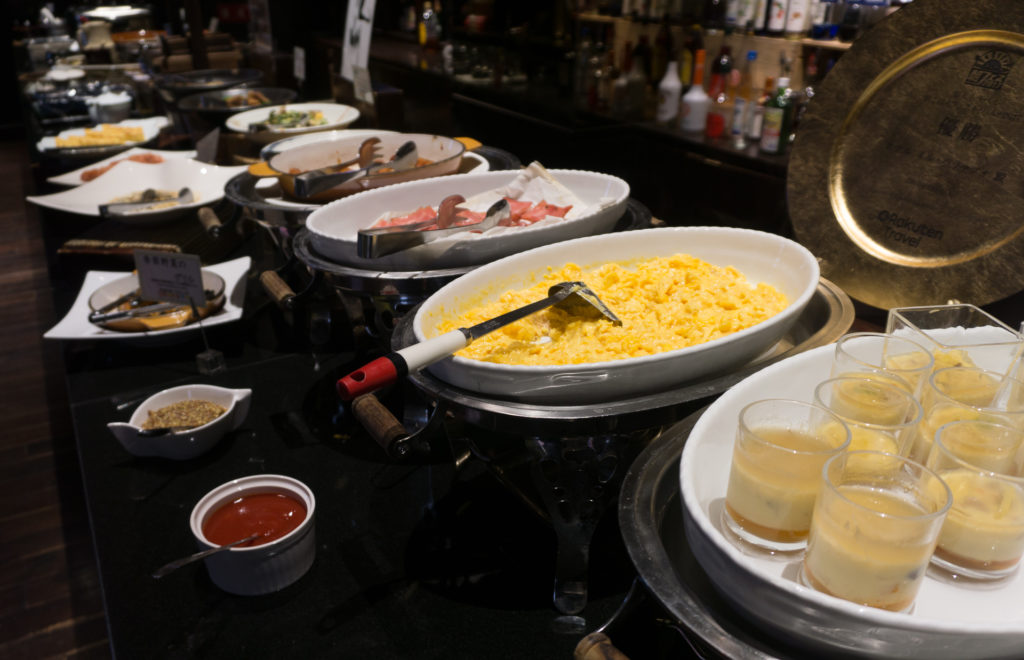
On another side of the buffet there is a fabulous salad bar and yogurt station where you can add fresh fruit or granola. There is also a large selection of pastries and croissants located next to the drink station that offers hot or iced coffee, tea, and a selection of juices. But be careful, as you may not eat lunch if you try it all!
Location: 3 Chome-13-1 Haruyoshi, Chuo Ward, Fukuoka, 810-0003, Japan // MAP
Grand Hyatt Fukuoka


On three of our most recent trips to Fukuoka, we’ve stayed at the Grand Hyatt Fukuoka located within Canal City Hakata, a fabulous shopping center with restaurants and fountain shows multiple times a day! We loved the location of the Grand Hyatt Fukuoka for public transportation and train travel because it was close to JR Hakata Station.
In addition to its terrific location, the luxurious Grand Hyatt Fukuoka has spacious rooms and bathrooms with extremely comfortable beds and many rooms have a view of Canal City Hakata.
Location: 1 Chome-2-82 Sumiyoshi, Hakata Ward, Fukuoka, 812-0018, Japan // MAP
The Best Things to Eat in Fukuoka
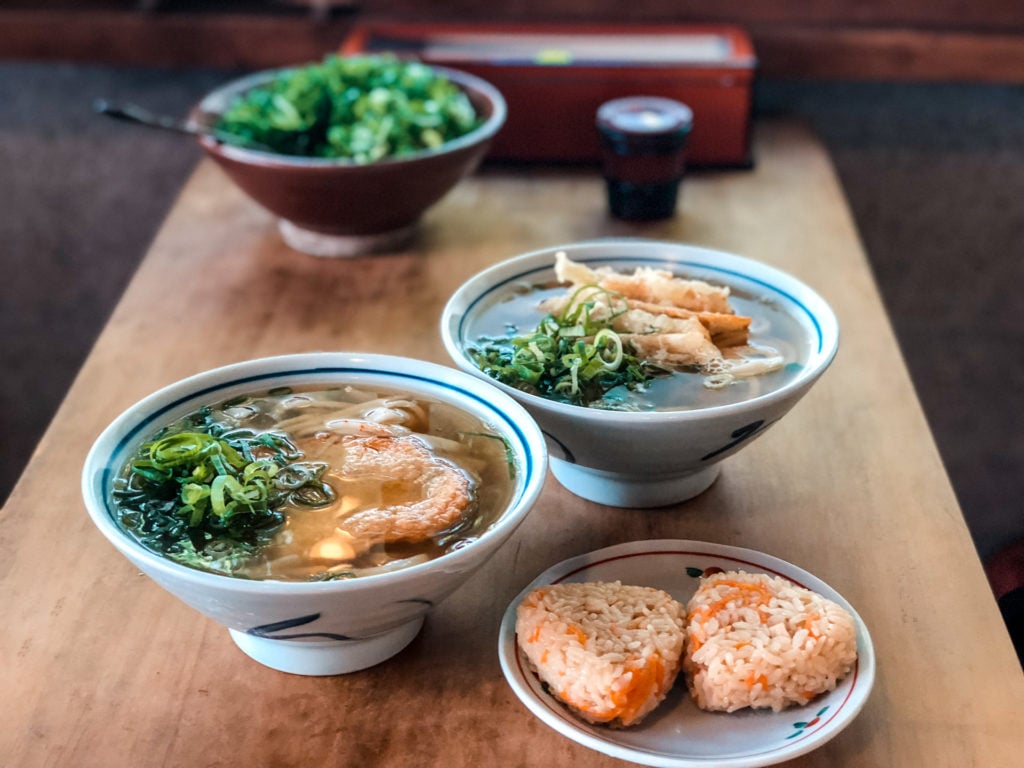


Fukuoka has long been one of my favorite foodie cities in Japan and I’ve been glad to see it becoming more popular. Here are some things you can’t miss when in Fukuoka and places to try these famous Fukuoka dishes!
- Hakata Ramen: Hakata Ramen, also known as Tonkatsu Ramen, is Fukuoka’s most well-known dish. Ichiran and Ippudo, two of Japan’s famous ramen chains, started in Fukuoka. To create a rich broth, pork bones are simmered for hours. The noodles are thin and straight and toppings include slices of chashu (pork belly), green onions, and soft-boiled egg.
- Goboten Udon: Another famous noodle dish in Fukuoka is goboten udon. It consists of thick, chewy udon noodles in a light broth topped with crispy gobo (burdock root) tempura. This is one of my famous Fukuoka dishes!
- Mentaiko: Mentaiko (cod or pollock roe) can be found in many dishes all over Japan. You can enjoy it marinated, with sushi, in soups, or even as mentai tamagoyaki a Japanese omelet with mentaiko inside that you can find at yatai food stalls.
- Saba (Mackerel): While Japan is known for fresh seafood, Fukuoka is one of the most famous cities for it, specifically mackerel which is fished right outside Hakata Bay. Mackerel is commonly cooked in Japan but in Fukuoka, you can try saba sashimi or goma saba, where slices of saba sashimi are covered in sesame, soy, and mirin marinade.
- Motsunabe: Motsunabe is one of Fukuoka’s most famous hot pot dishes. Motsu means pork or beef offal and nabe means hot pot. The soup has a soy or miso base creating a rich, salty flavor. Then meat and vegetables are added to the pot to cook. It’s a great dish to enjoy on a cold day!
- Mizutaki: Fukuoka’s second famous hot pot dish is mizutaki or chicken hot pot! This hot pot is made with chicken stock and you can boil chicken meat, dumplings, and vegetables inside the broth.
The Best Places to Eat in Fukuoka
Nakanishi Shokudo
If you decide to visit Shikanoshima Island during your Fukuoka itinerary, you should consider trying this Fukuoka food specialty,
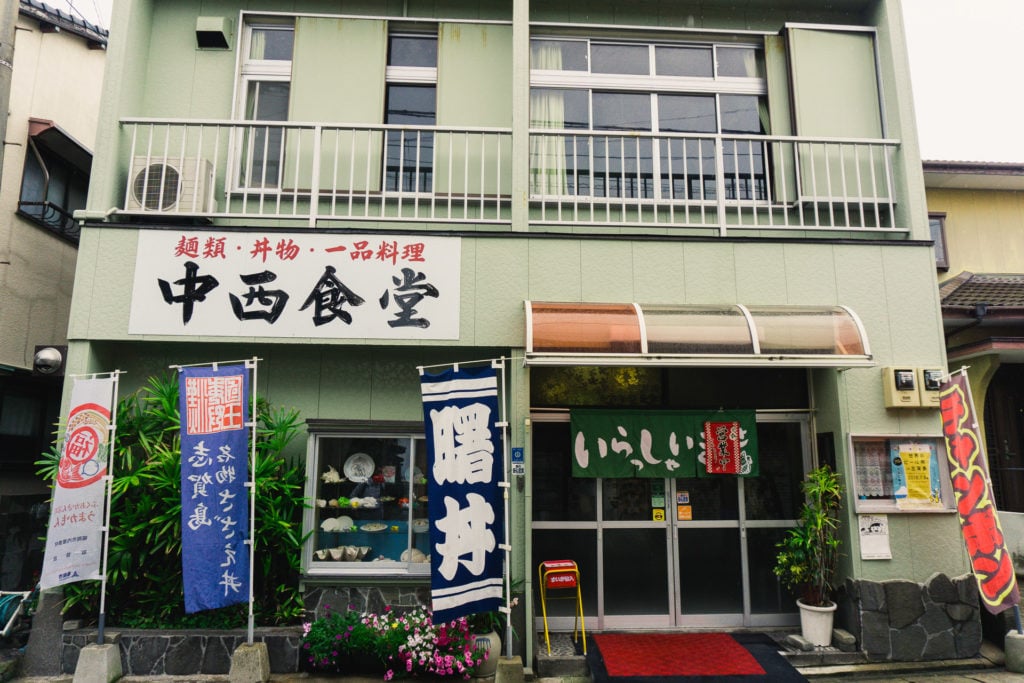
One day while on a bike ride around Shikanoshima Island, we stopped for lunch to enjoy one of Nakanishi Shokudo’s well-known
Our
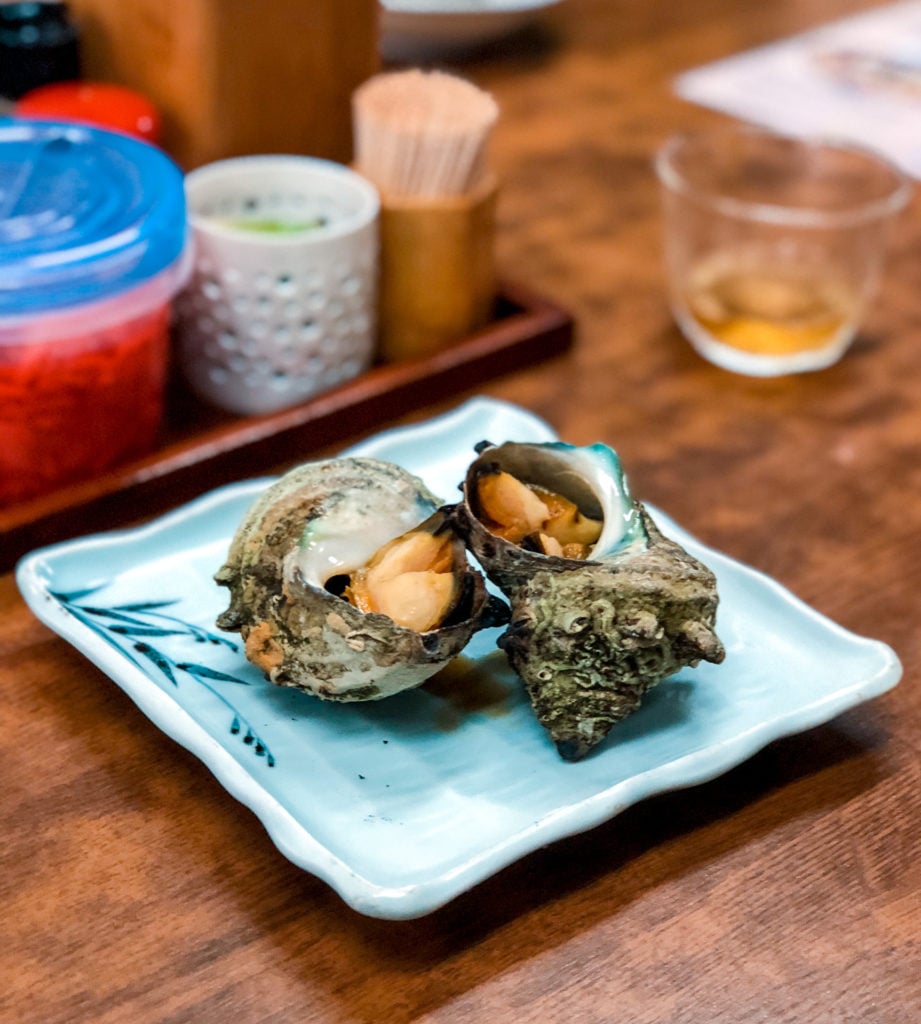
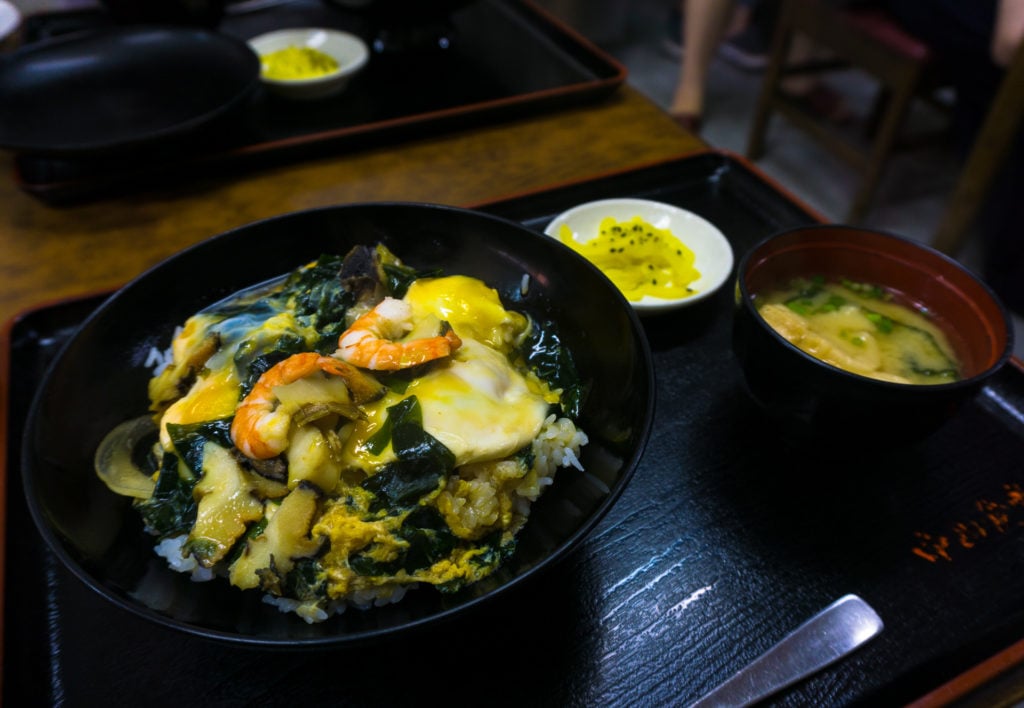
Location: 583-7 Shikashima Higashi-
Karonouron
Karonouron is a small, corner-side restaurant that was started over 150 years ago by the current owner’s grandmother. Uriu-san, now the head chef, has been working at Karonouron for nearly 40 years.
What makes Karonouron different from other udon shops? The family recipe hasn’t changed since the restaurant’s start! Karonouron uses a special kind of rare seaweed to add flavor to the broth and the udon noodles are made daily by hand. These special touches add to the rich history of Karonouron and the tastiness of their dishes.
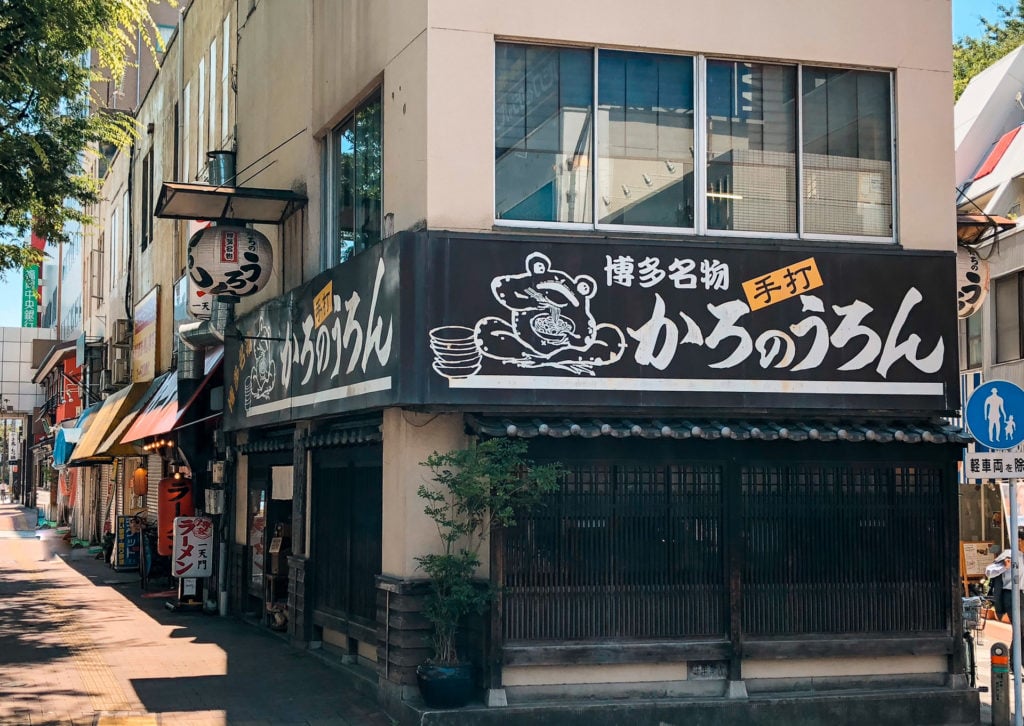
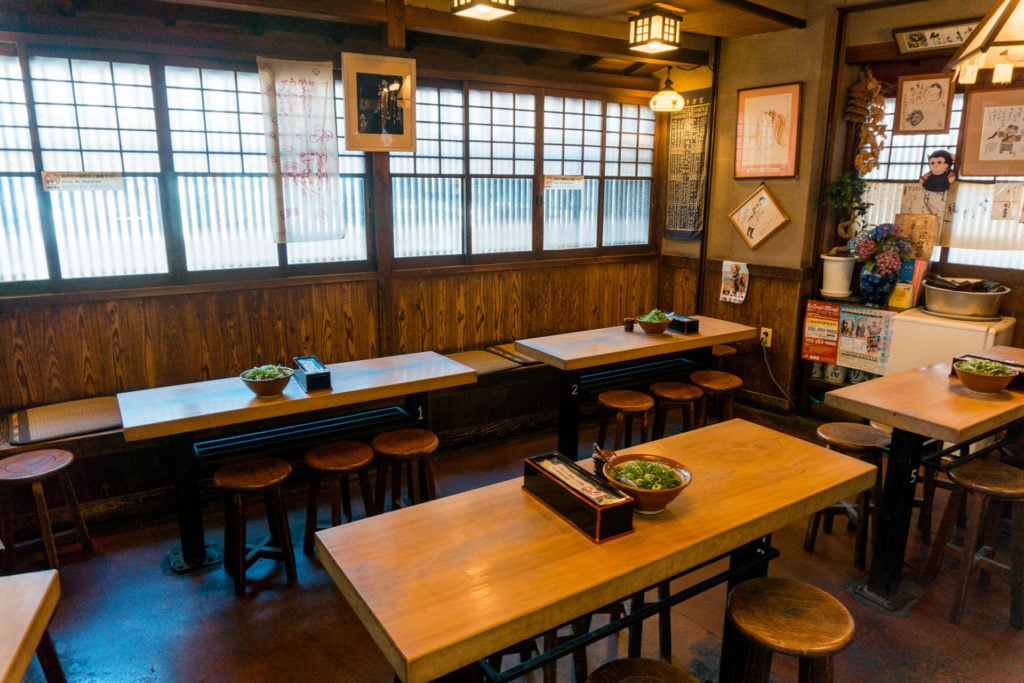
When first walking into Karonouron you’ll notice that the space extremely warm and inviting, there is space downstairs for customers as well as a few tables upstairs which is where we were seated. Immediately after we sat down, two glasses of chilled mugicha (barley tea) were brought to the table, perfect for the hot summer day. However, if you visit during the winter, you’ll probably receive some hot tea.
After, staff brought a large bowl of freshly chopped green onion. This is provided to all customers at no additional charge so you can add as much as you’d like to your udon bowl.
To start our meal we received a specialty side of Karonouron, chicken onigiri (chicken rice ball). We fought the urge to devour them immediately after the first bite because the flavor of the chicken broth soaked into the rice mixed with the tender pieces of chicken and crunchy carrots was incredible!
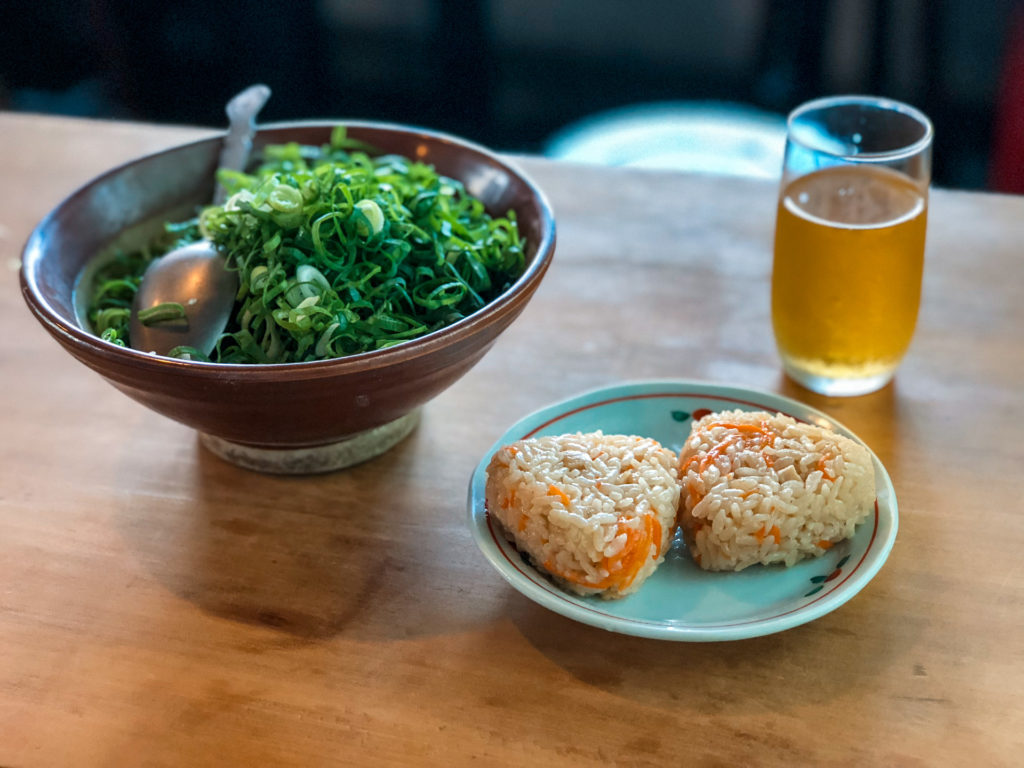
We each tried a different type of udon from Karonouron. Logan got the udon with a fried fish cake and I had the specialty of Karonouron, udon with fried burdock root known as goboten udon. Both of them were exceptional! The batter of the fried fish and burdock root stayed crisp as it sat in the bowl of rich udon broth and the thick-cut udon noodles were perfectly chewy.
We’d be hard-pressed to find a bowl of udon better than Karonouron. If you’d like to try Karonouron for yourself we recommend getting there early – once the udon is gone they close up shop!

Location: 2-1 Kamikawabatamachi, Hakata Ward, Fukuoka, Fukuoka Prefecture 812-0026 // MAP
Disclaimer: Karonouron does not allow photography inside their restaurant or of their dishes. We received special permission at the time of our visit due to our partnership with the Fukuoka CVB.
Tempura Hirao

Tempura Hirao is a casual tempura restaurant that is the perfect spot for lunch or dinner. First, you order from one of the two vending machines within the first door of the restaurant where you can pick out your items a la carte or by set. Once you make your selections and purchase you’ll receive tickets that you’ll eventually give to the staff.
If there is a line, you’ll be asked to wait on the benches behind the dining counter until a seat becomes available. Once there is space you’ll sit at the counter and give your tickets to the staff. Afterward, they’ll bring out your items as they are prepared so they are all fresh!
I ordered a tempura shrimp and fish set which came with miso soup, rice, and their signature salted squid that has some yuzu or other citrus fruit added to enhance the flavor of the squid. Considering how inexpensive this meal was, I was left very impressed by the quality of the crispy batter and perfectly cooked ingredients.
Location: 2 Chome-6-20 Daimyo, Chuo Ward, Fukuoka, 810-0041, Japan // MAP
Hanamidori
Nabemono, or simply “Nabe” is a Japanese hot pot cooking style. It typically consists of one pot with numerous ingredients often cooked at the table in a boiling broth. Before visiting Hanamidori, we had experienced Japanese hot pot many times, however it was the first time we had mizutaki or chicken hot pot which is famous in Fukuoka.
Before we began cooking our hot pot dish, we received a variety of appetizer dishes that reminded us of kaiseki dining (assorted small plates). These small dishes included egonori (seaweed noodles), cod roe, pumpkin tofu, roasted eggplant edamame, and seared chicken ham.
Hanamidori is also known for chicken sashimi, a highly regulated dish that is strictly prepared. Of course, chicken sashimi might not be for everyone but if you are interesting in trying it, I recommend doing so at Hanamidori.
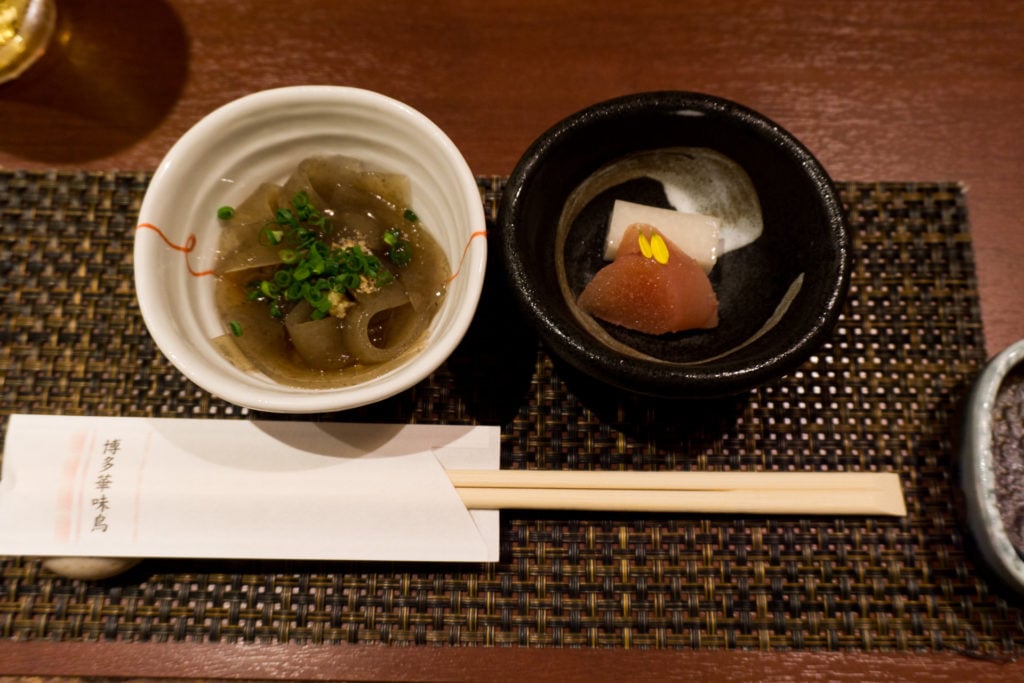


After enjoying our small plates, we were brought a large pot of broth that quickly began to boil on the hot plate. Our server carefully placed each piece of chicken in the broth to simmer. While we waited they formed perfectly round chicken meatballs to also be placed in the broth to cook. These were my personal favorite!
Hanamidori has a specialty broth that accentuates the flavor of each piece of chicken and the chicken was moist and tender. After our chicken had cooked for a little while, we added some vegetables to simmer including bok choy, carrots, mushrooms, and tofu.
At the end of our meal, we were given a bowl of
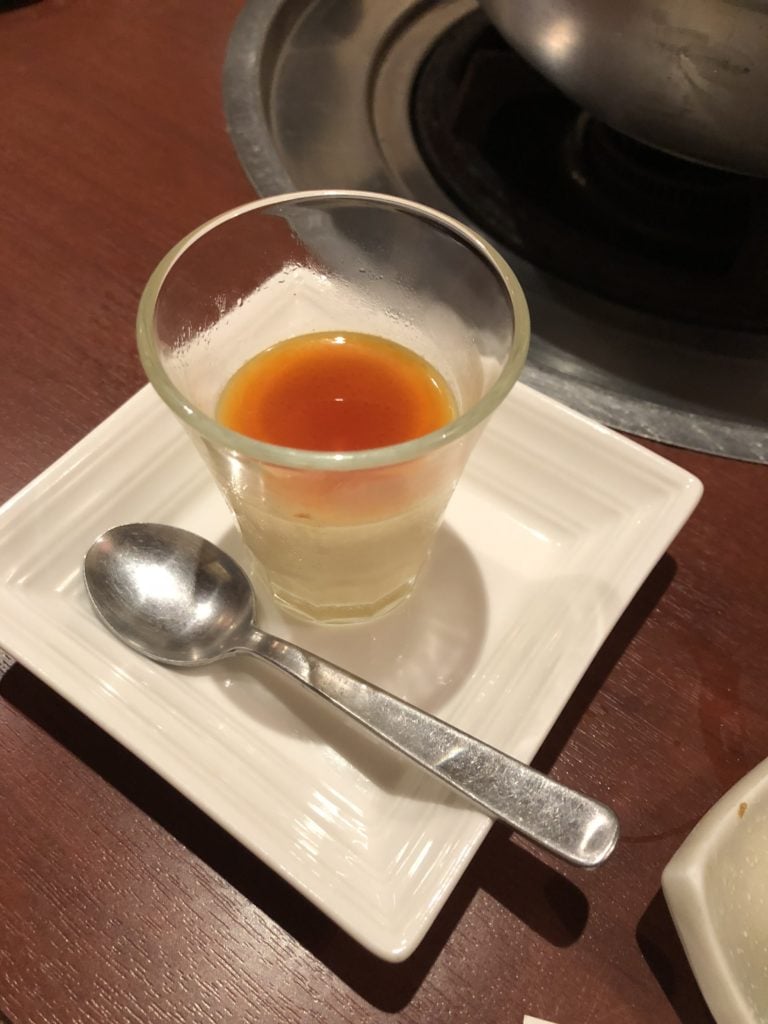
Location: 5-4-24, Nakasu, Hakata-ku, Fukuoka-shi, Fukuoka, 810-0801 // MAP
Hakata Izumi
Hakata Izumi is a Michelin-rated restaurant well-known for fugu (or blowfish). Miyatake-san is the head chef at Hakata Izumi, and Fugu is a tradition passed down in his family for generations.
It takes years of practice and strict licensing by the government to prepare fugu as some parts of the first are poisonous, so this dish might not be for the faint of heart! Fear not though, as Miyatake-san is a master of the art of fugu and prepared a once-in-a-lifetime meal for us that we still can’t stop talking about.

During our dining experience at Hakata Izumi, we selected one of the set courses that allowed us to try fugu prepared in a variety of ways. Our course included an appetizer, sashimi, deep-fry, hot pot, porridge, and a dessert. For a complimentary amuse-bouche, we tried fugu sake gelatin. The chilled, smooth texture of the gelatin absorbed the flavor of the sake and the fugu creating a sharp flavor which a chewy texture.
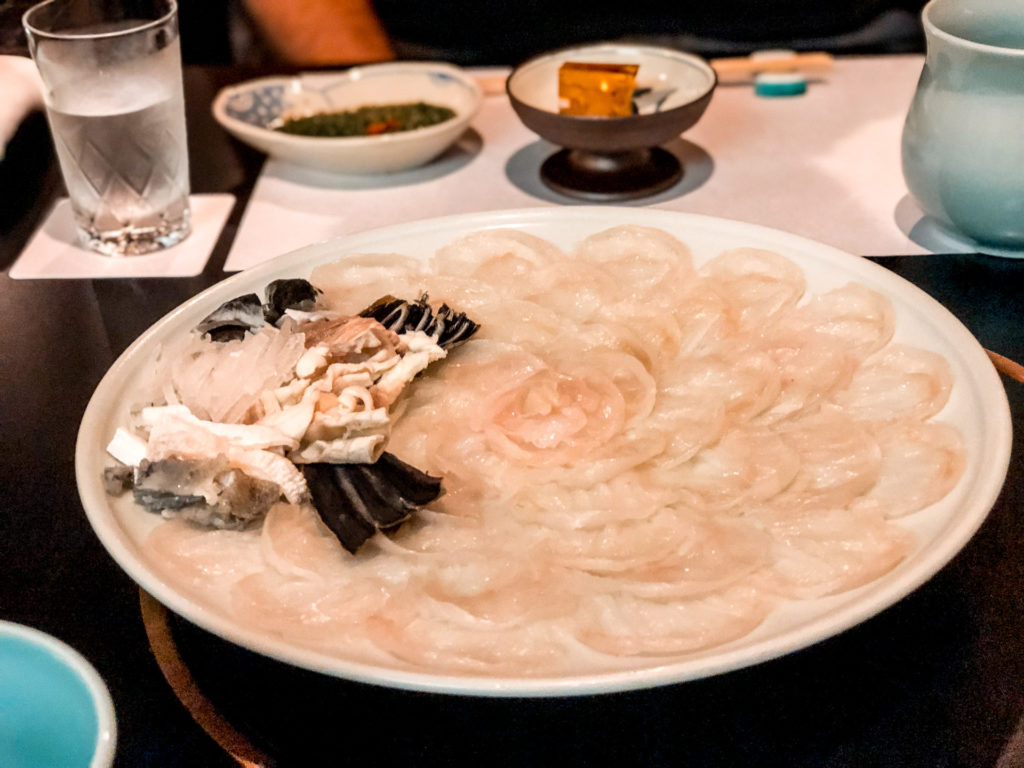
For the first course, we tried fugu sashimi. Fugu sashimi is sliced with extreme precision by a technique called nimaibiki making each piece razor-thin. Each piece is then meticulously placed on a plate to create a visually appealing flower shape.
Since fugu is cartilage without fat the texture is slightly chewy compared to other types of sashimi you might be familiar with. The flavor is enhanced by dipping into a house-made ponzu sauce with green onion and some spices. We also tried the fugu sashimi with olive oil and sea salt which changed the flavor profile completely! We recommend trying it both ways to see which you enjoy best. My personal favorite was the ponzu.
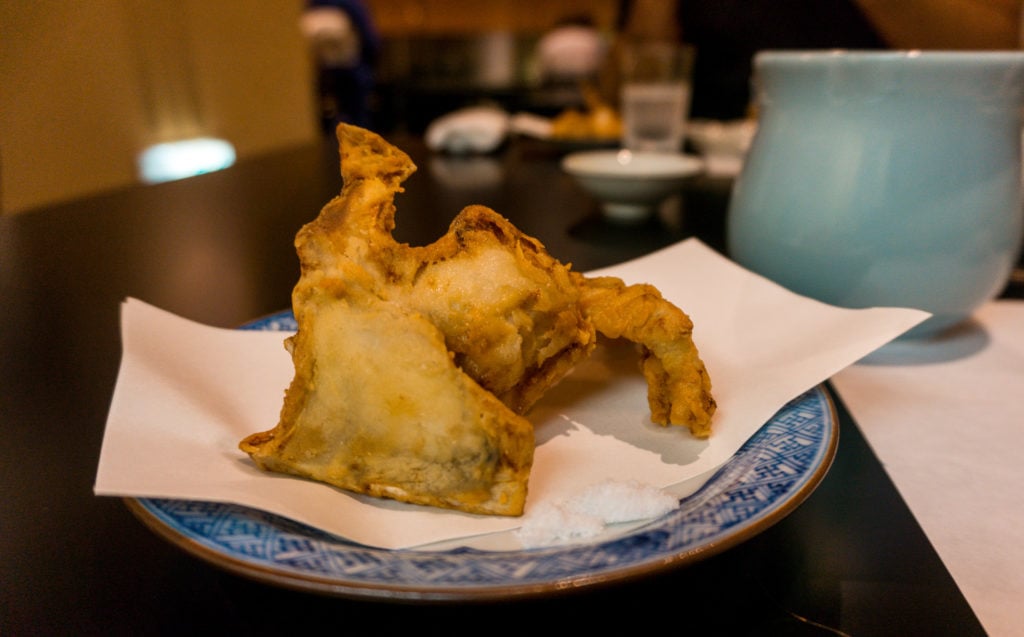
Next, we had fugu karaage (deep-fried fugu). Each piece was coated in a tempura batter that enhanced the umami aspect of the fugu. Unlike most fried fish, the crispy coating was not overly greasy and light. It was one of our favorite courses on our tasting menu.

After, we tried fugu hotpot. The fugu was cooked in a light broth and accompanied by vegetables and a rice porridge, similar to congee. The vegetables and rice were cooked in the same broth to capture the fugu flavor harmoniously. This was the most subtle of all the preparations but the meat was tender due to the slow simmer process.
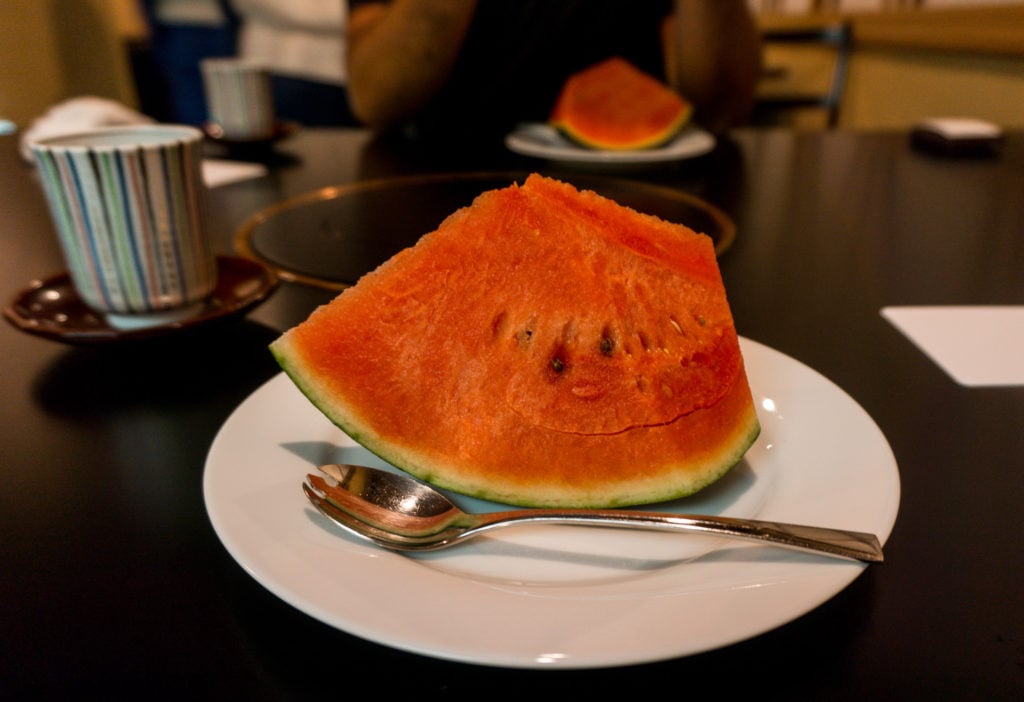
For dessert, we had a slice of fresh watermelon. Fruit is often considered a dessert in Japan and watermelon is often considered more of a delicacy as it is typically more expensive. It was extremely sweet and refreshing! The fresh fruit that Hakata Izumi offers changes based on availability and seasonality.
Our first experience with fugu was an experience unlike any other, and we highly recommend it to those looking to try something new and exciting!
Location: 2-20-14, Sumiyoshi, Hakata-ku, Fukuoka-shi (by the Sumiyoshi Bridge in front of Hakujinkai Hospital) // MAP
Price: Course meals start at ¥10,000 per person, you may also order items al la carte
Hakata Ramen at Ramen Stadium
On the 5th floor of Canal City Hakata is the Ramen Stadium which has a collection of some of Japan’s most iconic ramen shops from various regions or prefectures of Japan – including the famous Hakata ramen in Fukuoka. Just head to the top floor, buy a meal ticket from one of the vending machines, and line up – you’ll soon be served a delicious comforting bowl of ramen!
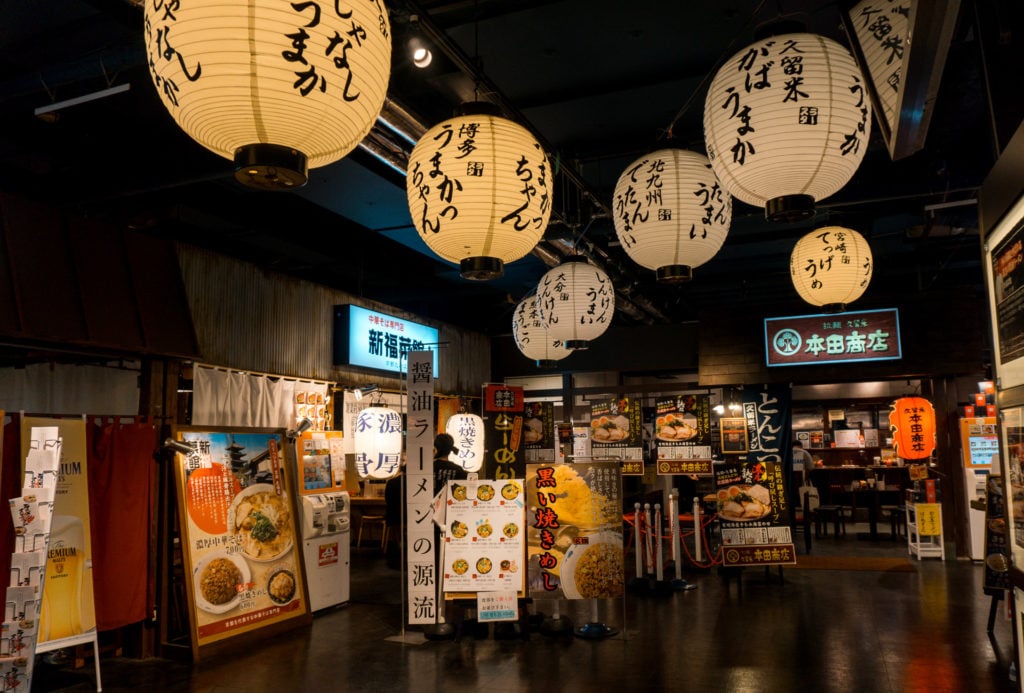
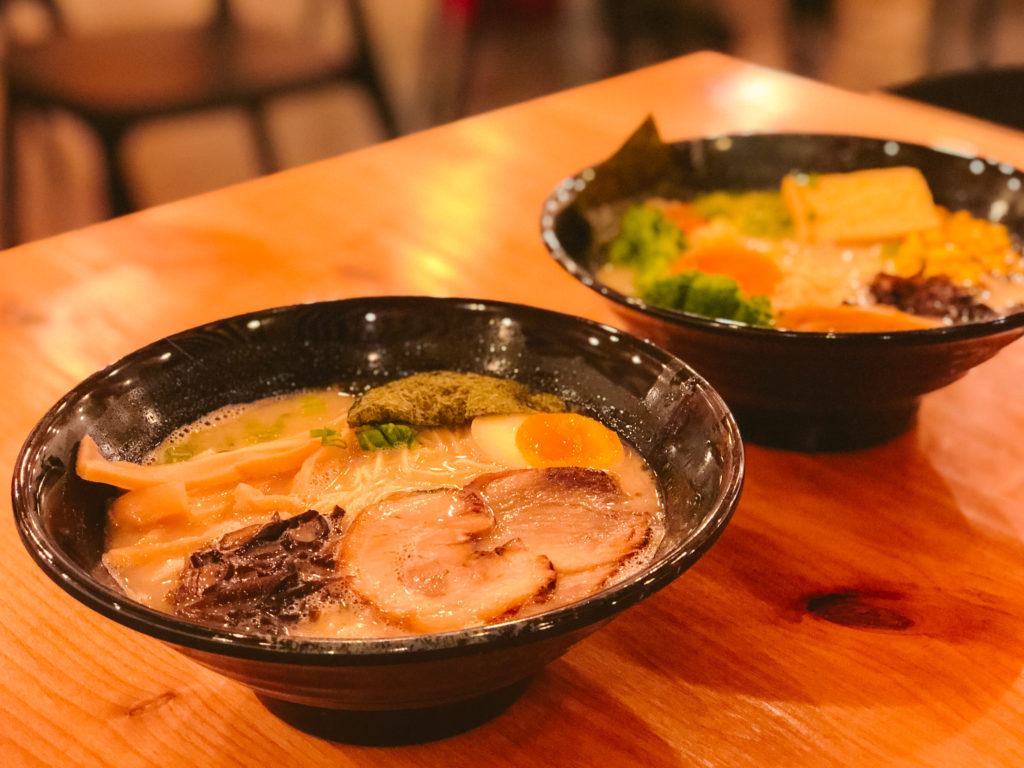
A few of the restaurants I recommend at Ramen Stadium are:
- Visit Ramen Jinanbo Hakata Oh for delicious traditional Hakata-style ramen! If you like a little spice add some chili oil.
- If you want to try Tonkatsu ramen in a new way, try a bowl at Tonkatsu Tsukemen Ando. They have a concentrated pork bone soup with green onion and bamboo shoots. It is served on the side of a bowl of ramen noodles, a soft-boiled egg, and seaweed that you can dip into the broth.
- Quickly growing 333 Shami has been referred to as the next big thing in the ramen world. The broth is a chicken stock base with over 10 types of vegetables and is then blended with tomatoes. It has the perfect blend of tangy, subtly sweet, and savory flavors. Then it is topped with chashu (pork belly) and a variety of vegetables. If you leave some of your broth at the end of your meal you can pay an extra 300 yen to have them make a risotto with Italian cheese.
Shokudo Mitsu
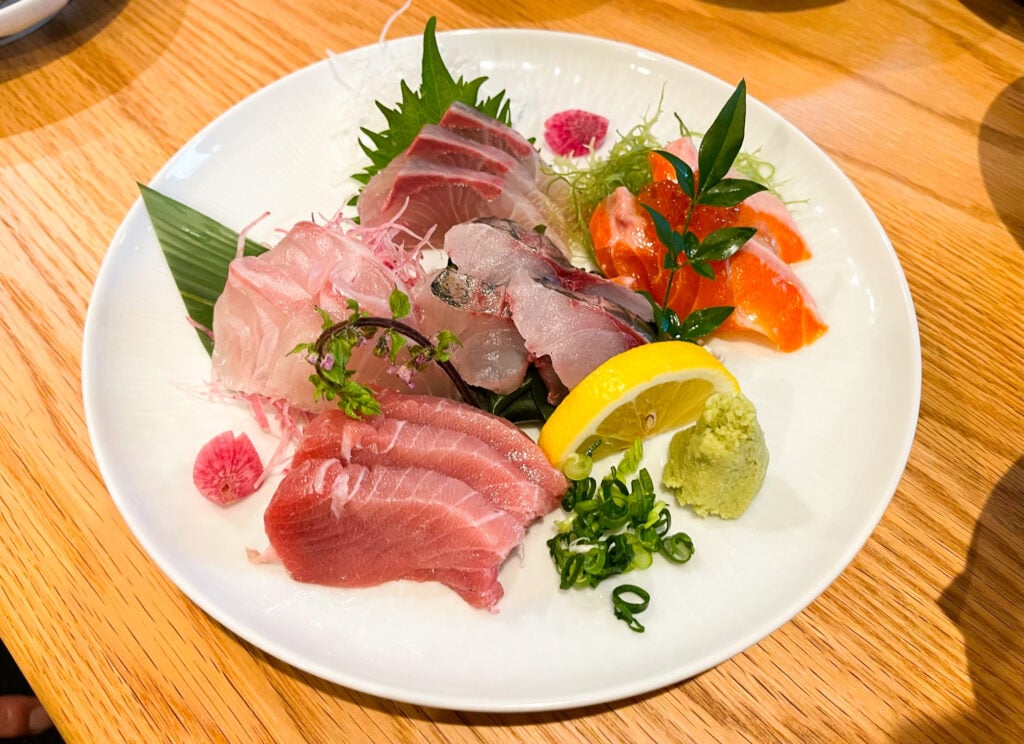
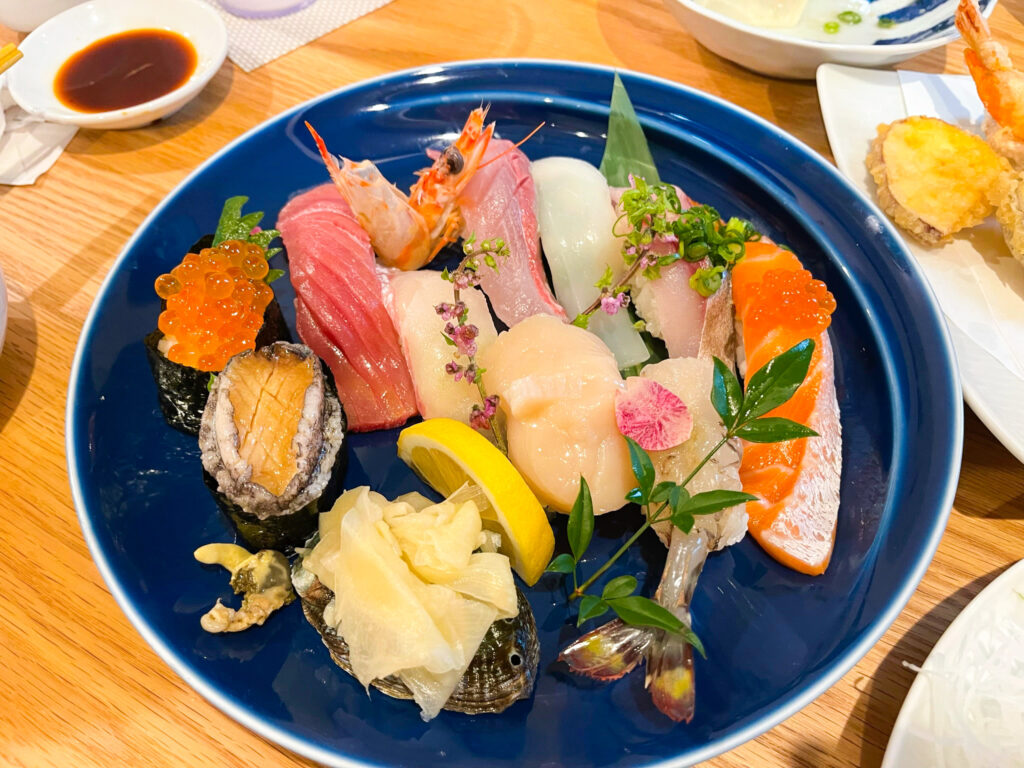
On one of our visits to Fukuoka, we met up with a friend at Shokudo Mitsu for sushi. Little did I know this would be one of my most memorable sushi meals I’ve had in Japan and it wasn’t just the company we shared! The fish at Shokudo Mitsu is extremely fresh and had such buttery, rich flavors. I was left highly impressed by each bite!
We enjoyed a variety of sashimi and nigiri sushi allowing the chef to pick their freshest and best fish (omakase style!). My personal favorite will always be tuna whether it be akami (lean tuna), chutoro (medium fatty tuna), or otoro (fatty tuna). However, I also really loved the fresh scallops (hotate), salmon (sake), sea bream (tai), and sweet shrimp.
Because Shokudo Mitsu is a smaller restaurant, I recommend making a reservation in advance so you can enjoy the delicious taste of fresh sashimi from Fukuoka!
Location: Japan, 〒810-0003 Fukuoka, Chuo Ward, Haruyoshi, 1 Chome−6−1 柳橋連合市場 内 // MAP
Yakitori Hareruya


Despite being so close in proximity to Canal City Hakata and other popular tourist destinations, this small counter yakitori restaurant feels like you’ve taken a step outside of the busy city center. Yakitori Hareruya was a random find for us when we were walking around one evening in Fukuoka, and we decided to stop in after smelling the smoky chicken being grilled. We greatly enjoyed the atmosphere of the restaurant as much as we enjoyed the food!
We started off with two of my favorite small plates kyuri tsukemono (pickled cucumber) and tamagoyaki (rolled egg omelet). This was quickly followed by a variety of yakitori skewers such as chicken skin and negima yakitori (green onion chicken) and other kushiyaki like shishito peppers, unagi (eel), bacon-wrapped enoki mushrooms, tender pork belly, and more. To complete the meal, we shared some yakionigiri (grilled rice balls).
Location: 2 Chome-15-1 Sumiyoshi, Hakata Ward, Fukuoka, 812-0018, Japan // MAP
Yatai Food Stalls in Fukuoka
One of Fukuoka’s most famous foodie spots is Yatai. These food stalls are located along the Naka River, a central location in Fukuoka. Feel free to stroll by the stalls to work up your appetite and see what each has to offer! Needing a late-night meal? No worries, Yatai food stalls are open late!
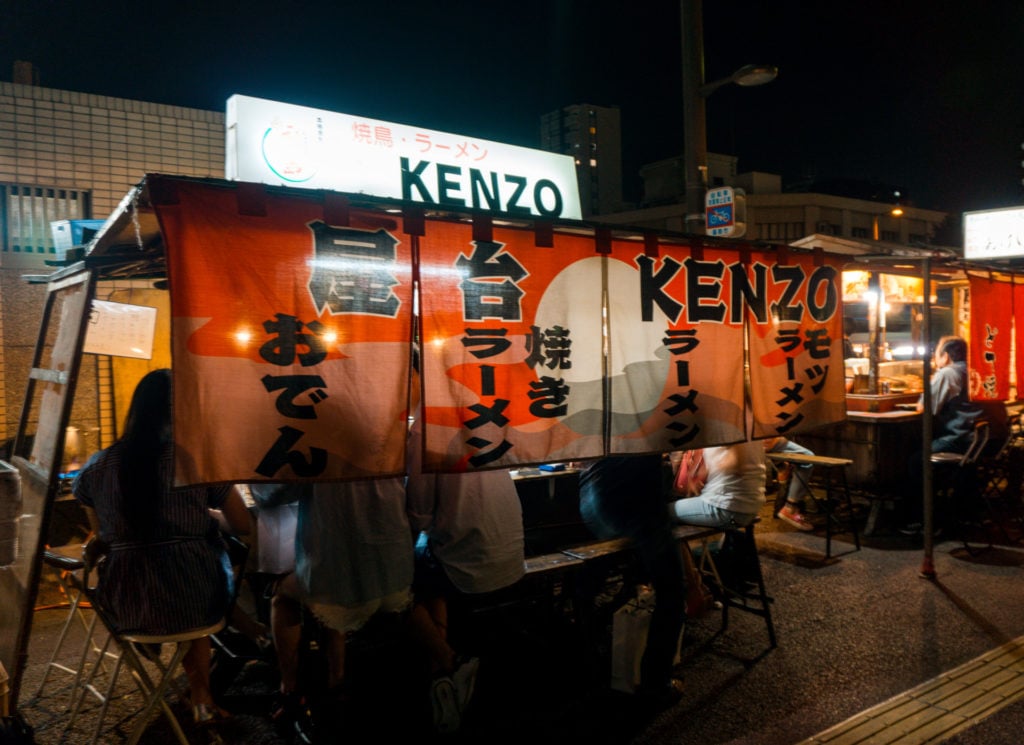
Yatai is a dining experience that is completely different than dining at a typical restaurant or grabbing some street food and moving on. It is chaotic and lively, and often you may come as a stranger and leave with new friends. Every time we visit Fukuoka we always try to make time for Yatai. On our first experience, we jumped into a yatai food stall which specializes in yakiramen, or pan-fried ramen, and various kinds of kushiyaki.

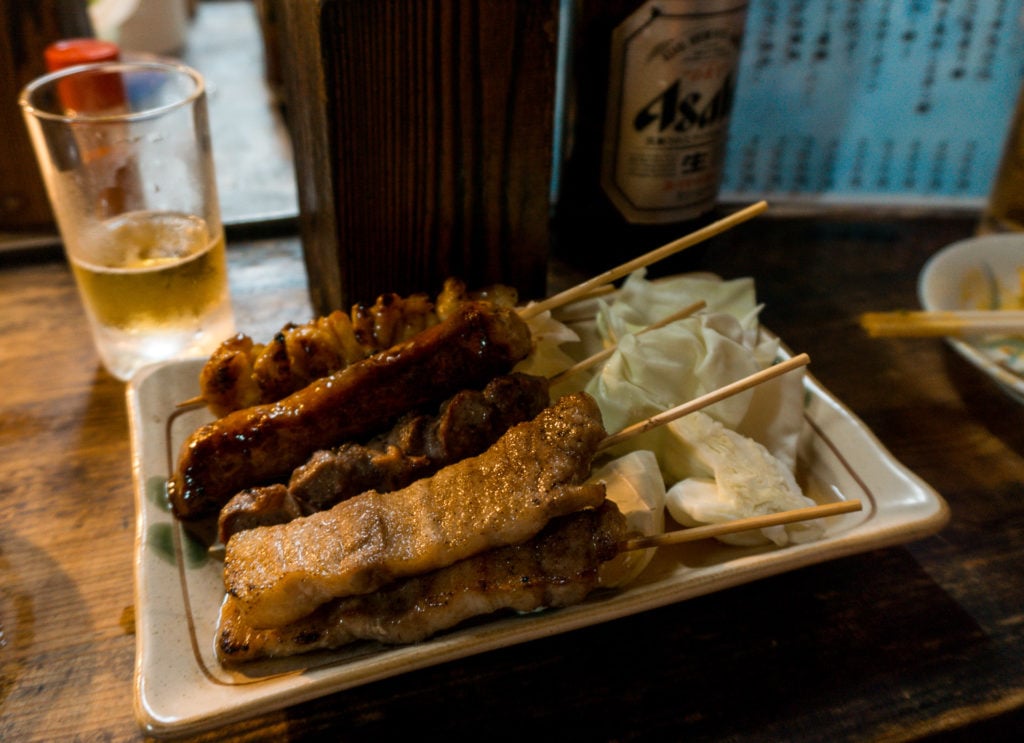
After a few beers and some
Address: 〒810-0801 Fukuoka Prefecture, Fukuoka, Hakata Ward, Nakasu 5 Chome, Showa-dori Street // MAP
Unique Things to Do in Fukuoka
Explore the Beautiful Uminonakamichi Seaside Park
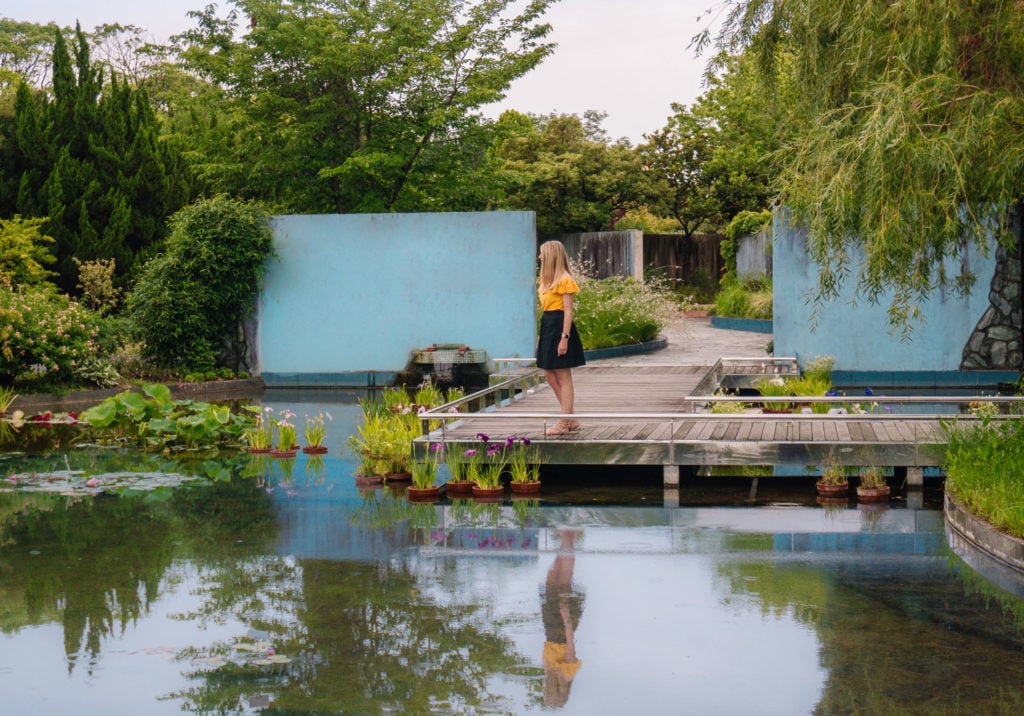
One of my favorite things to do in Fukuoka is visit Uminonakamichi Seaside Park. It is a large, leisurely park that is just outside of the city. At this Fukuoka attraction, you can enjoy beautiful flowers and plant life that varies by season. We’ve visited in spring, summer, and fall and each brings different beauty.
In the summer, Uminonakamichi Seaside Park has over 40 hydrangea species with over 10,000 flowers that provide a beautiful setting and alluring floral scent as you walk through the park. You can easily spend the morning strolling around the park admiring the tranquil water features lined with beautiful flowers.
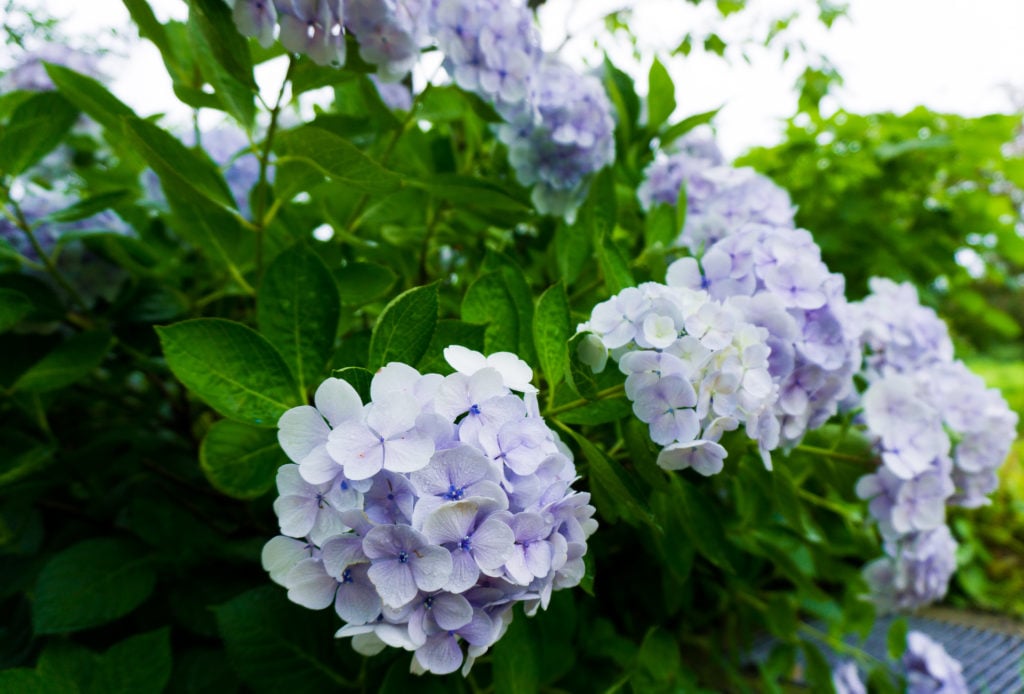
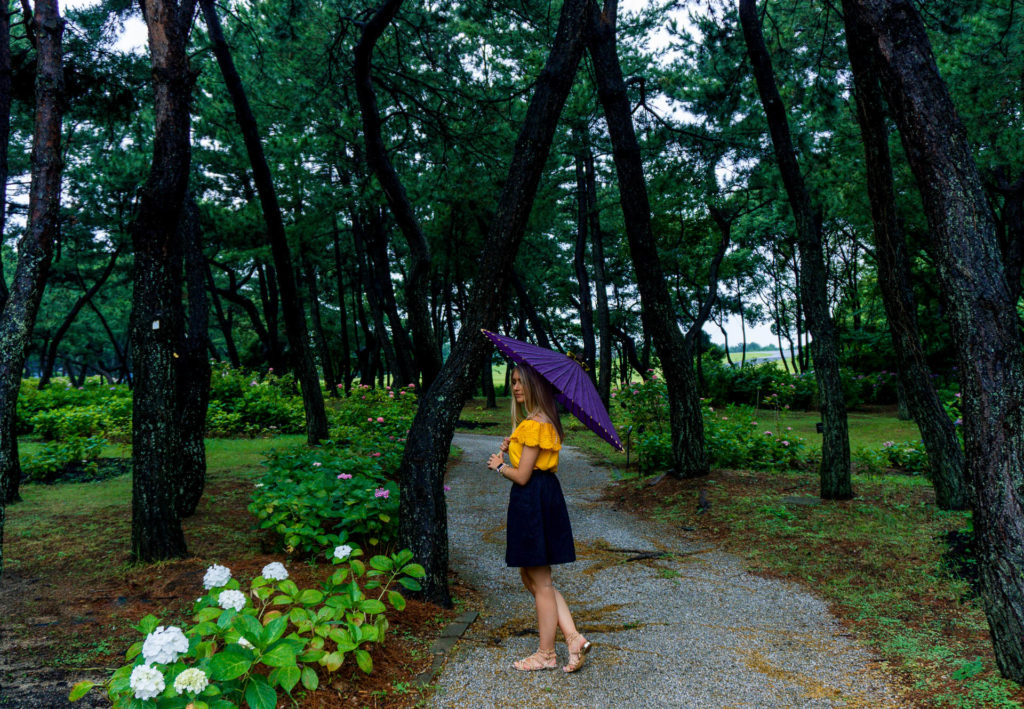
In the spring, it is you guessed it… sakura season! Uminonakamaichi Seaside Park is one of the places to see the best sakura in Fukuoka with countless trees lining the park’s bike paths and rows of trees around the park.
But Uminonakamaichi Seaside Park doesn’t just have flower fields and gardens, it also contains the largest swimming pool in western Japan, accompanied by six smaller pools, and even water slides to cool off on a hot summer day. Best of all? This waterpark is included in your admission price!
Other experiences you can have while at Uminonakamaichi Seaside Park include animal encounters featuring capybaras, kangaroos, squirrel monkeys, prairie dogs, flamingos, and swans. As well as a free woodworking class that includes plants and wood scraps found in the park.
Since the park covers roughly 300 hectares (~740 acres) one option for transportation is to take a trolley around the park. Each ticket is 200 yen for one way, or you can purchase an all-day pass for 500 yen. But if you’re looking for a more personal way to view the park there are also bicycles available to rent where you can head out on your own and ride along the 12km paved trail.

There are four different stations to rent bikes from and you can return them at any of the four you desire. Be sure to stop by the Shiomidai Lookout while on your bike ride to see the spectacular view of the nearby Genkai-nada Sea!

Flower Calendar for Uminonakamaichi Seaside Park
- January: Narcissus
- Late January-Mid April: Rape Flowers
- February: Christmas Rose
- Late March-Early April: Cherry Blossoms
- April: Tulips
- Late April: Nemophila
- Mid-May-Early June: Roses
- Mid-June-Early July: Hydrangea
- October: Cosmos
Location: 18-25, Oaza Saitozaki, Higashi-ku, Fukuoka
Hours: March 1st-October 31st: 9:30-5:30, November 1st-February 28: 9:30-5:00
Price: Admission – ¥450/adults,¥210/seniors, children under 14 are free, cash only
Bicycle Rental – Adults: ¥400/3 hours (¥70/30 minutes after), ¥700/one day, Child: ¥250/3 hours (¥30/30 minutes after), ¥400/one day, cash or IC card only.
Parking (cost per day) – Standard Size: ¥520, Motorcycle: ¥260
READ MORE: Important Things to Know Before Traveling to Japan
Tour Shikanoshima Island by Bicycle
Another one of our favorite areas to bike in Fukuoka is Shikanoshima Island. Shikashima Cycle is the perfect place to rent a high-quality bike to tour Shikanoshima Island.
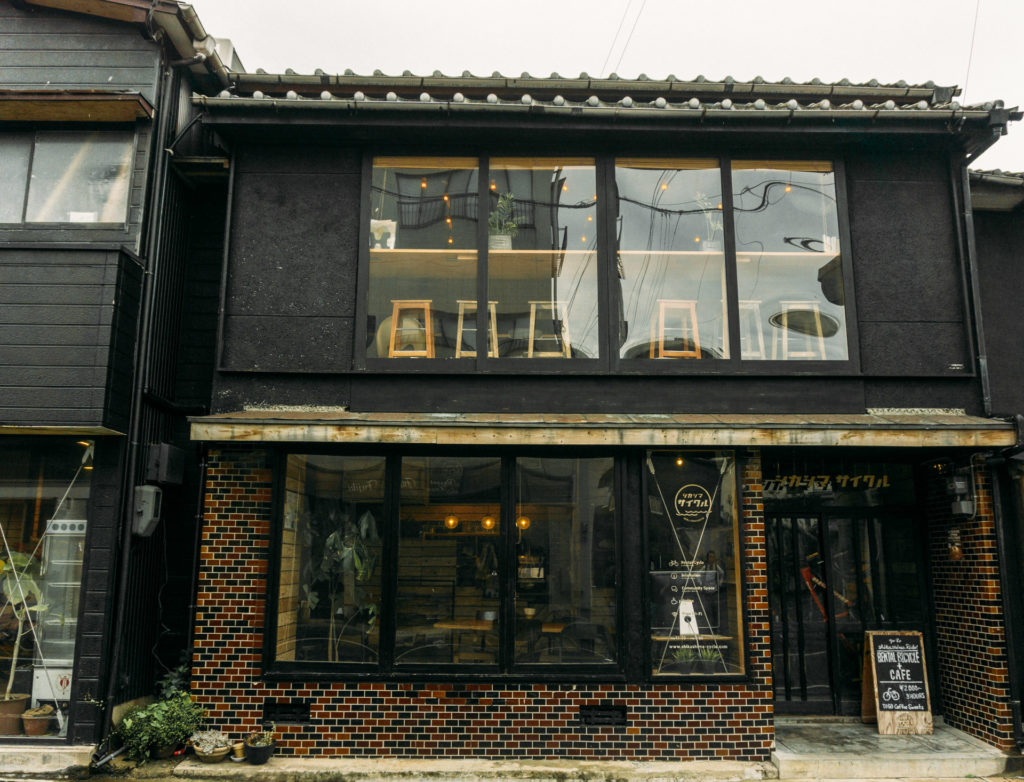


The entire island is roughly a 10km ride and takes about one hour to complete without stops. However, there are many places we recommend you stop at while you enjoy the beautiful ride around the island including Shikanoshima Bridge and Beach, Shikaumi Shrine, Shiomi Park, and Nakanishi Shokudo for lunch.
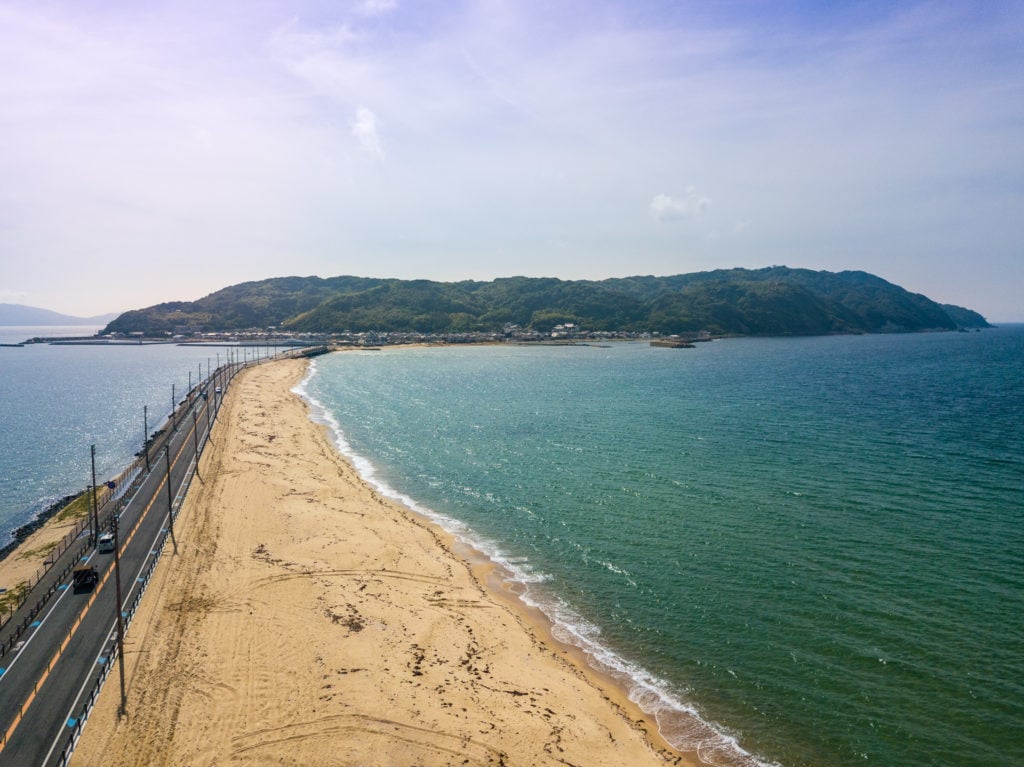

After your bike ride, enjoy a delicious beverage at Shikashima Cycle’s cafe. Shikanoshima Island is known for its oranges, so on a summer visit we tried a seasonal drink, a bitter orange soda made with muddled oranges and mint that came locally from Shikanoshima Island. It was the perfect way to refresh after the workout!
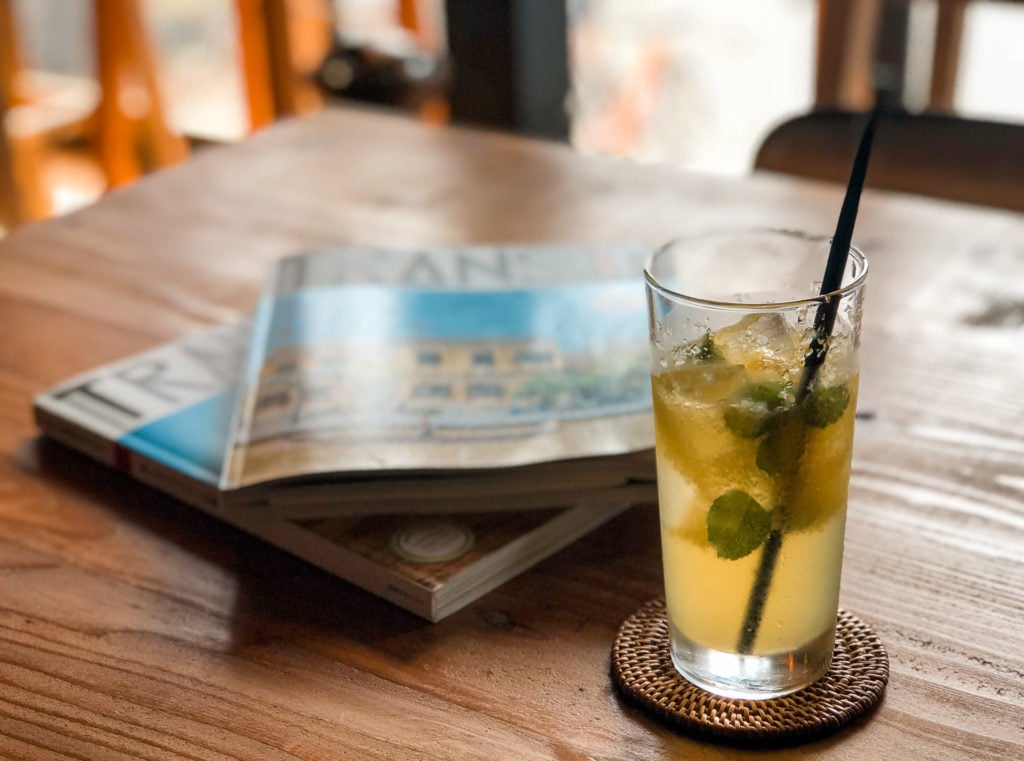
Address: 417-1, Shikanoshima, Higashi-ku, Fukuoka City // MAP
Hours: Sunday-Saturday: 19:00-18:30, closed Tuesdays
Price: ¥2,500 for a trekking bike or ¥2,000 for a mountain bike (3-hour rental, ¥500 for every additional 30 minutes)
Visit the Historic Shikaumi Shrine
Shikaumi Shrine is dedicated to the three gods of the sea. While the exact age of Shikaumi Shrine is unknown, it is dated to be at least 200AD; the physical shrine you can visit today has been there for over 400 years. If you are on a bike ride, walking, or driving, it is worth a pit stop to see this beautiful shrine tucked away in the forest with a beautiful view of the bay.

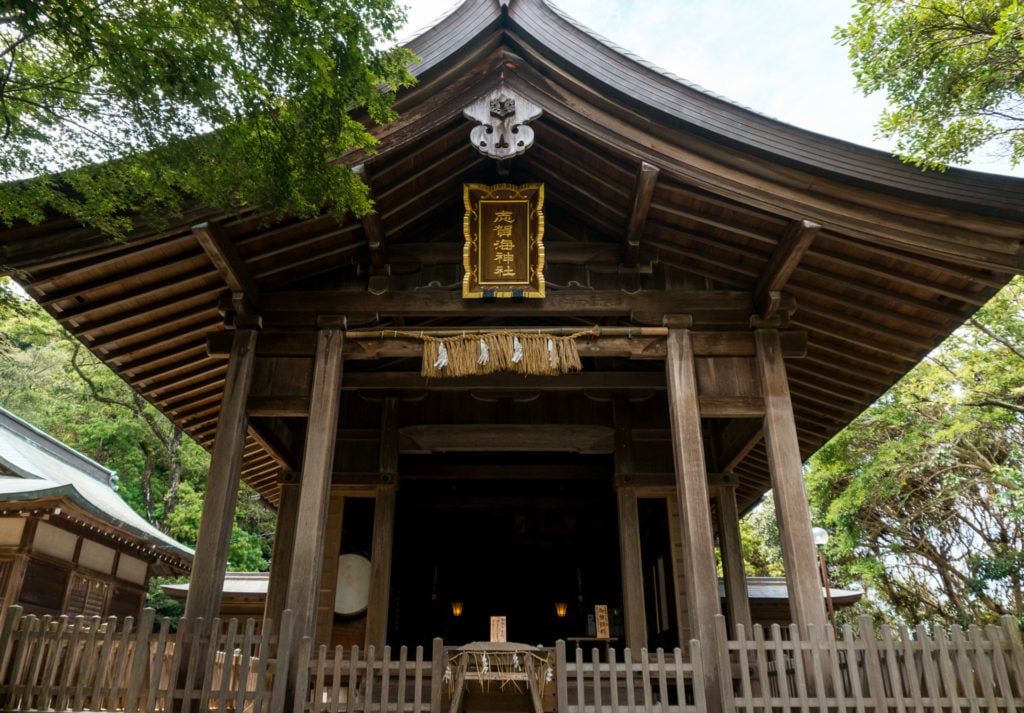


Location: 877, Shikanoshima, Higashi-ku, Fukuoka City // MAP
Enjoy Entertainment and Shopping at Canal City Hakata
Canal City Hakata is a mall and entertainment complex that is so large it has been called a “city within a city!” Numerous retail stores, restaurants, cafes, live theaters, cinemas, and beautiful water features are found within the confines of Canal City. It was built in 1996 and is reported to be the largest privately developed project in Japan, with over 17 million people visiting annually!

There are many different stores to shop at Canal City Hakata, a few of our favorites include Donguri Kyouwakoku, a character store based on many Studio Ghibli films, Dagashi Yumeya, a shop that has a lot of Japanese traditional or novelty snacks and sweets, and DesignPocket a store where you can buy and/or make food replica items that are common in Japan!
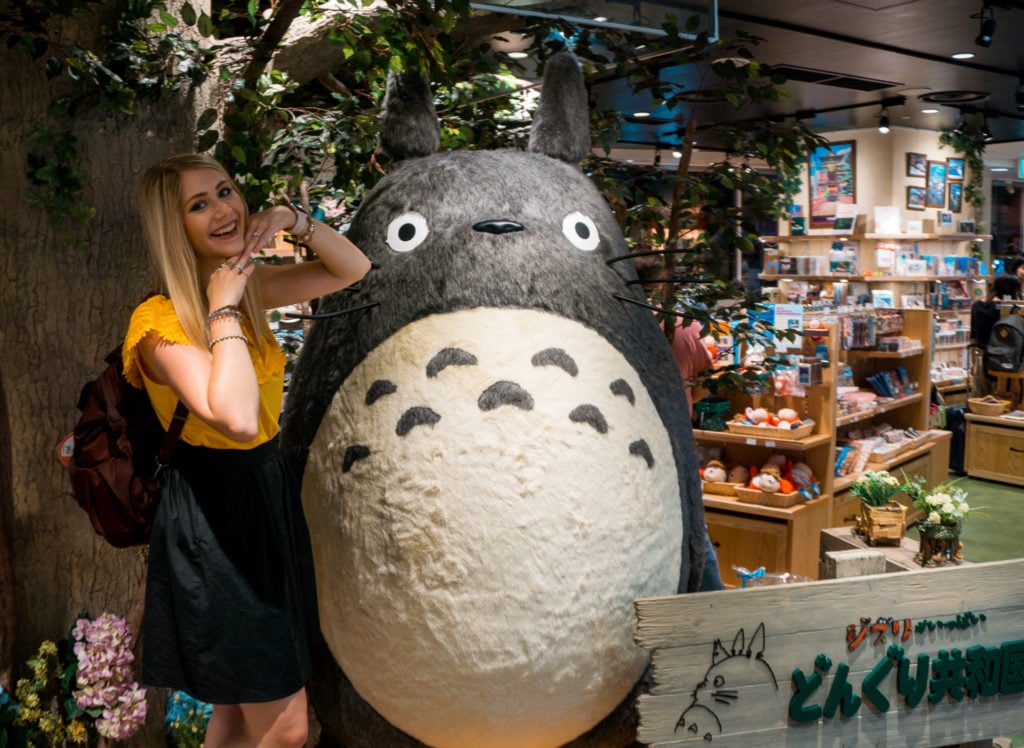


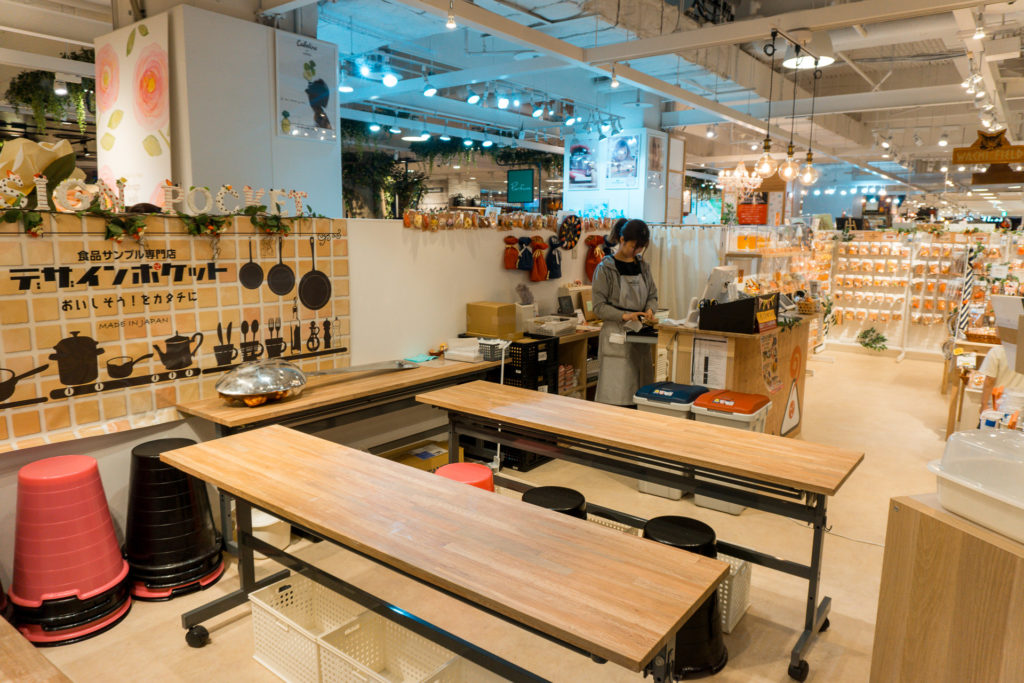
For international travelers, there is a tourist information center on the first floor of Canal City Hakata. Staff can provide information about Canal City Hakata, Fukuoka, or even the entire Kyushu region. You can also rent a kimono or ninja costume, make a t-shirt with Japanese calligraphy, place your luggage in a storage locker, or enjoy a light snack and drink!
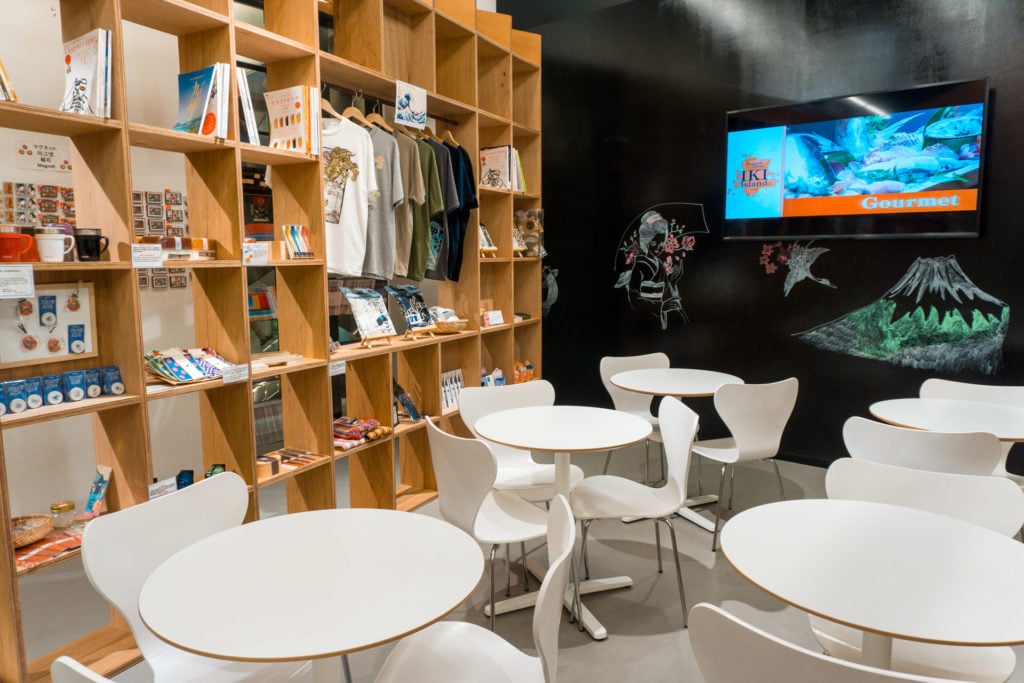
While Canal City Hakata is bustling during the day, it comes to life at night with the Aqua Panorama Show which features a 3D projection map combined with water fountains, neon lights, and electric sounds. On weekends between 8:00pm-9:00pm there is a free interactive show.
During one of our visits, we were faced with a mission to protect Canal City Hakata from Godzilla’s attack! It was such fun interactive activity to enjoy with friends, family, or as a couple. Simply follow the link to see what digital events are coming up.


Address: 1-2, Sumiyoshi, Hakata-ku, Fukuoka // MAP
Take the Ferry to Nokonoshima Island Park
Start your day off early with this cherished place in Fukuoka! Hands down this place is always one of the highlights of our time in Fukuoka and we hope you love it too.
Before heading to Nokonoshima Island we grabbed breakfast and then drove in our rental car to the Nokonoshima ferry stop. Nokonoshima Island is a paradise that is just a quick ferry ride away from Fukuoka City. While only around 700 people live on Nokonoshima Island year-round, the island has many local and foreign visitors annually.
One of the most beautiful areas of Nokonoshima Island is the flower fields which showcase different species depending on the season. During our summer visit, we were able to see golden yellow and bright orange marigolds that were radiant in the summer sun.
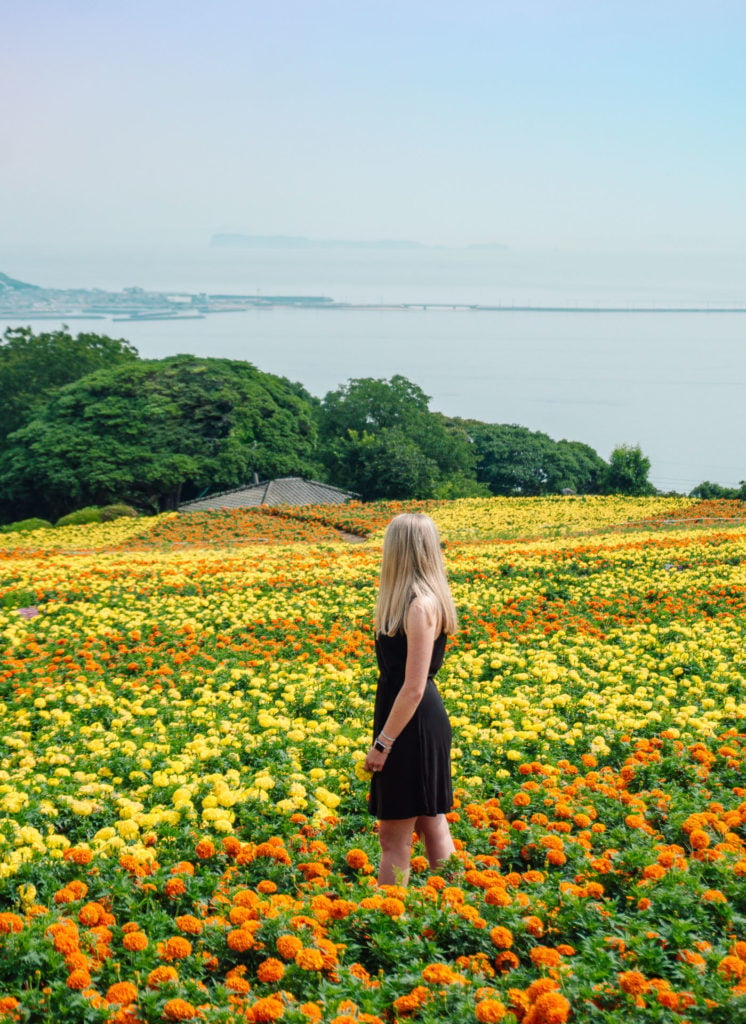
While many come for the flower fields, Nokonoshima Island has many other activities to offer visitors. The island has its own matsuri (festival) including one for children that takes place in February-March.
There are various playgrounds for children to enjoy, a volleyball court, NokoNoko – the island’s version of 9-hole golf, a petting zoo area, a soccer field, gift shops, and an art-house where you can create and decorate a pottery piece. Needless to say, with such a variety of activities available on the island you’re sure to find something for everyone to enjoy.
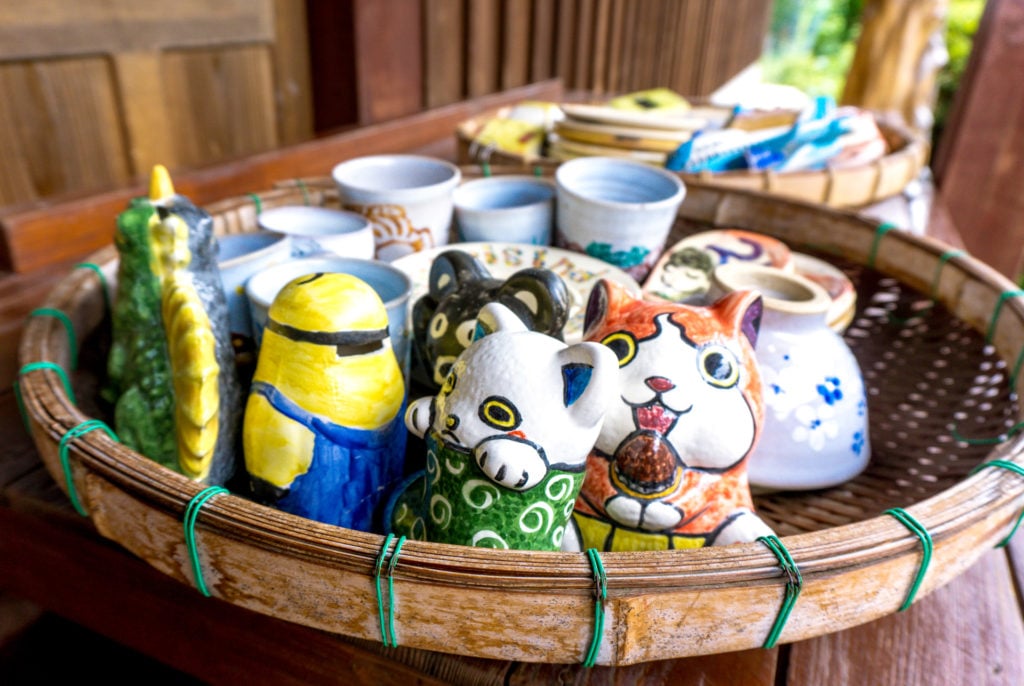


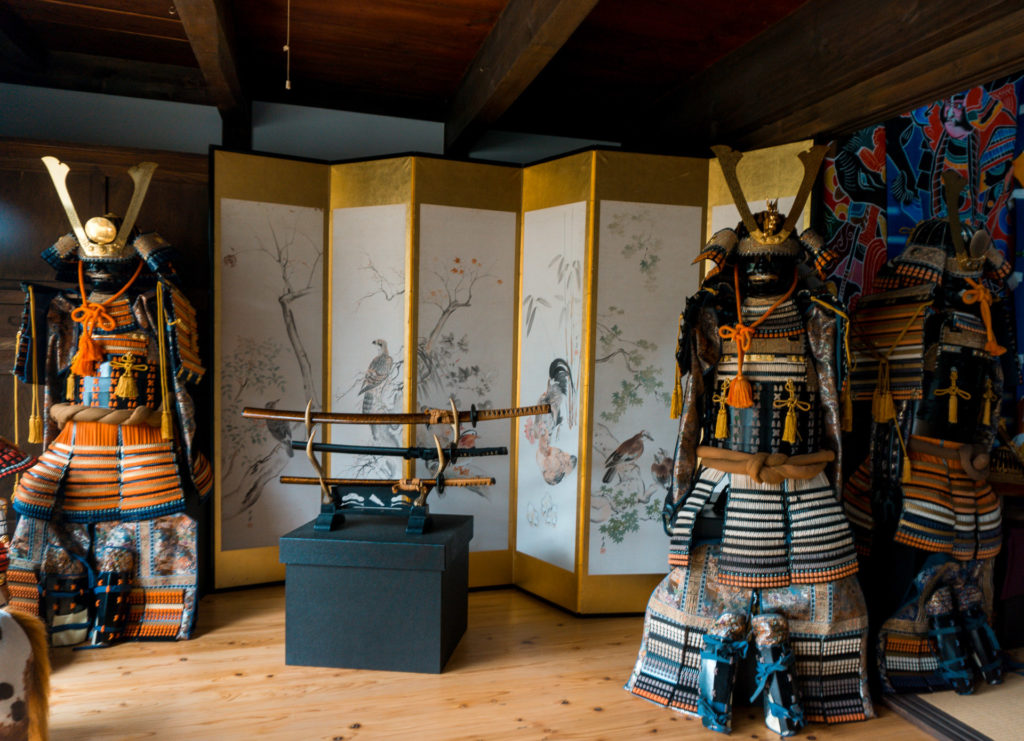
Since there are so many experiences available, you can easily spend a day visiting Nokonoshima Island. No need to make plans to leave for lunch or dinner as there are quite a few restaurants that you can dine at on the island including Sakimori (the island’s specialty) which has a charcoal grill with fresh meat, seafood, and vegetables, as well as Noko Udon, an udon noodle shop, and Cafe Yumeji which has tea and cakes.
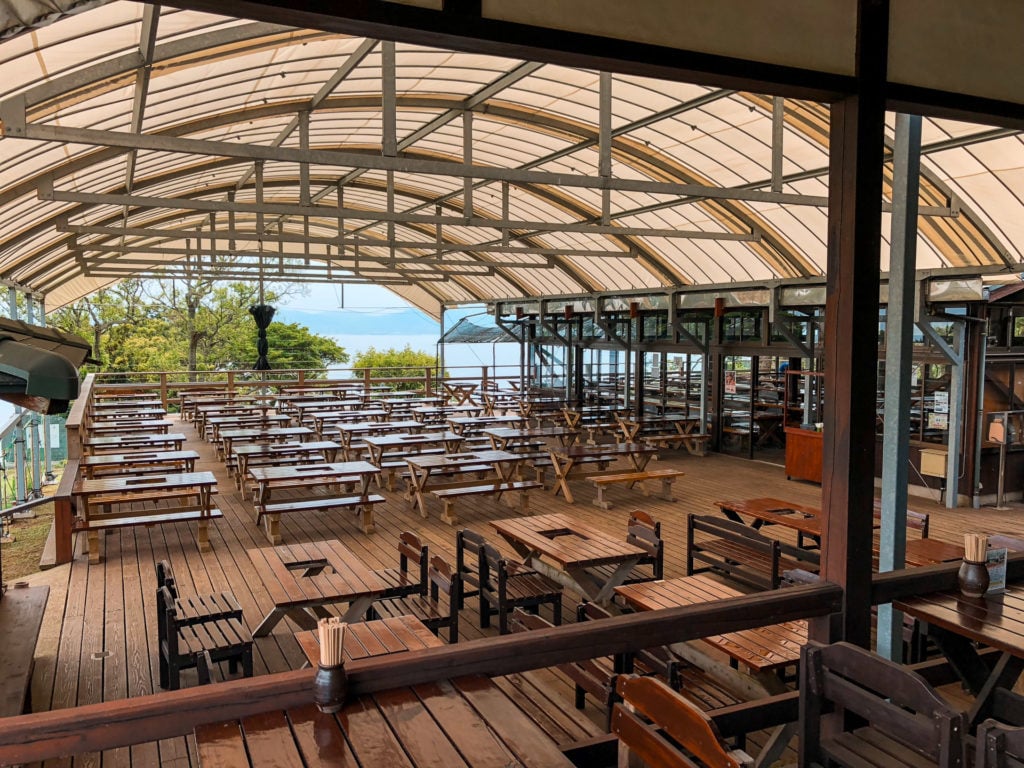
If you plan to stay the night at Nokonoshima Island there are two areas you can rent a place to stay. In the summer months, you can enjoy a seaside stay at a Nokonoshima Camp Village where you can barbecue and enjoy many other amenities including a floating trampoline, banana boats, and swimming.
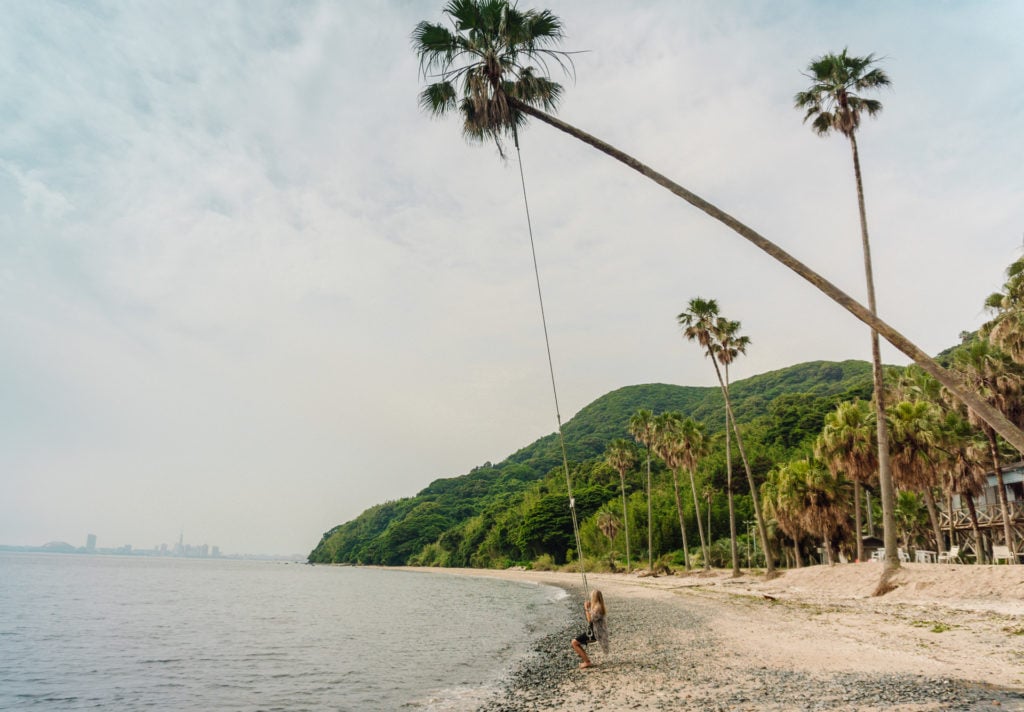
While Nokonoshima Camp Village wasn’t open during our visit, we still had the chance to enjoy the beach views and see the behind-the-scenes preparation for the summer months. At night, you can light fireworks or build a campfire while enjoying the calm Hakata Bay view. Another place available for lodging is a villa at Sakimori-no-Sato which has a view of the flower gardens and Hakata Bay.
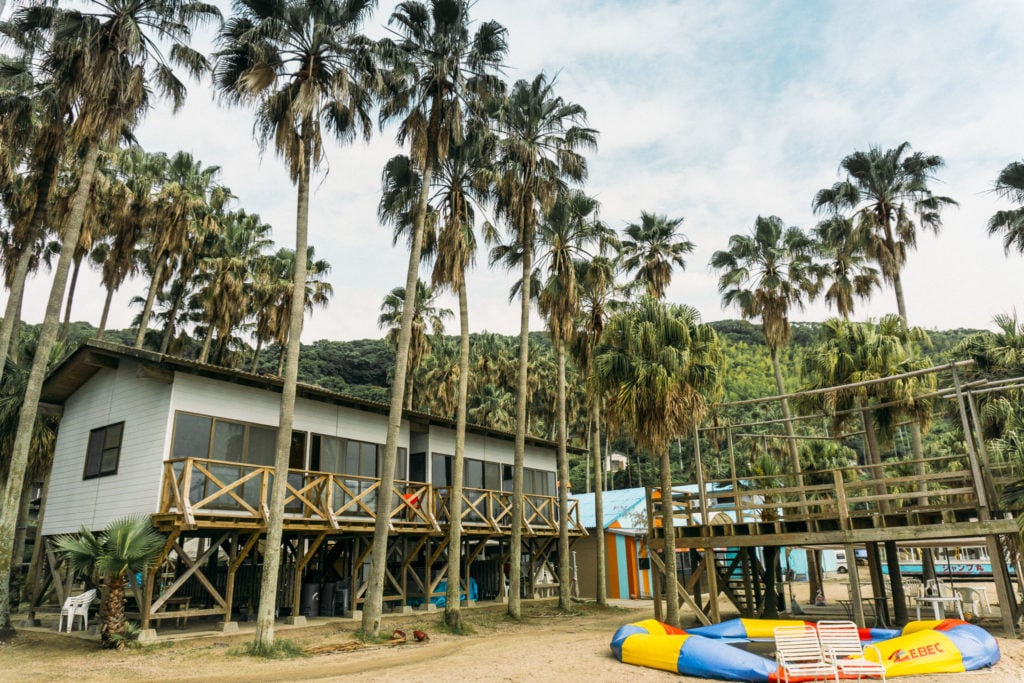
Something else we noticed about Nokonoshima Island was the accessibility for those with young children, those with disabilities, or the elderly. Canes were available free of charge for those who needed one to assist in walking the steeper hills and stroller rentals and electric wheelchairs were available as well for small fees.

Nokonoshima Island is a beautiful place to relax from the hustle of urban life and enjoy a romantic getaway or retreat with friends or family and we always have the desire to return!
Flower Calendar for Nokonoshima Island
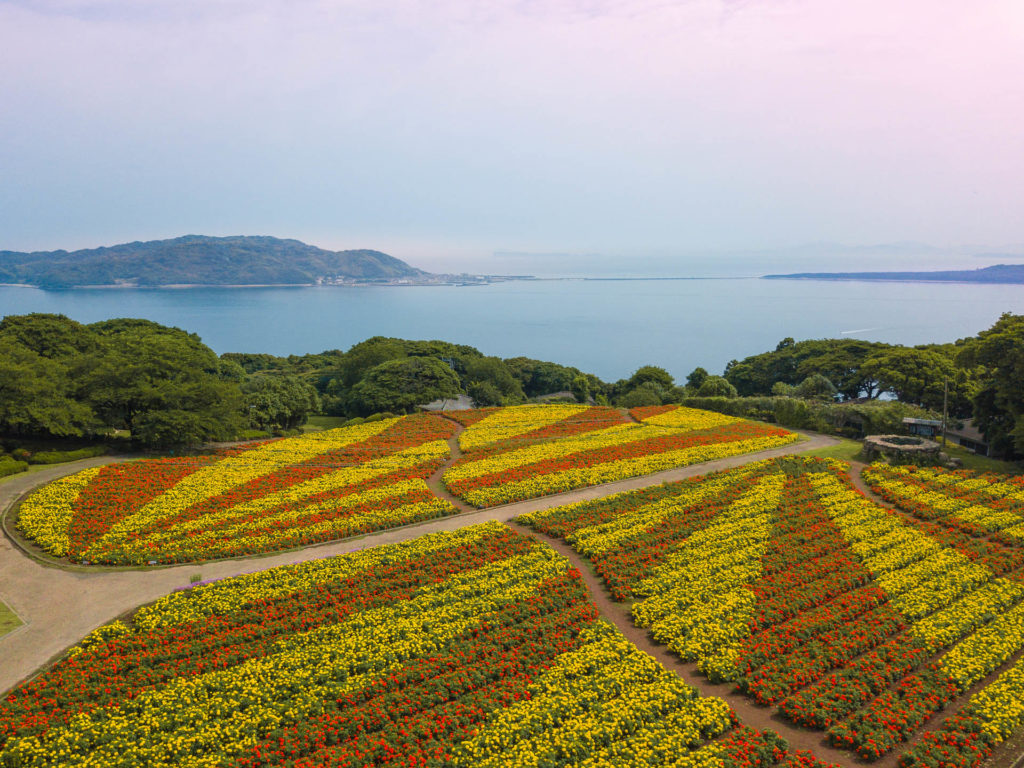

- Late February to Mid-April: Rape Blossoms
- Mid-March to Early May: Livingstone Daisy
- Late March to Early April: Cherry Blossoms
- April: Azalea
- May to June: Marigold
- June: Hydrangea
- Mid-July to Mid-August: Sunflowers
- Late September to Mid-October: Cosmos
- Late October to Mid-November: Late Flowering Cosmos
How to get to Nokonoshima Island Park

- Nishitetsu Bus (to the ferry terminal):
- JR Hakata Station (Platform 1 – main entrance): No 300, 301, 302 – 40 minutes
- Tenjin Iwataya-mae (Platform 11): No 5 – 30 minutes
- Tenjin Mitsukoshi-mae (Platform 1A): No 300, 301, 302 – 25 minutes
- Subway: Get off at Meinohama Station and take one of the following:
- Nishitetsu Bus – Meinohama Station: No 98 for ferry terminal – 10 minutes
- Taxi to ferry terminal- 5 minutes
- Car: You can also drive to the ferry terminal and park in the on-site parking lot. Time varies depending on your location.
- Ferry: The Ferry from Nokonoshima to Meinohama leaves every half hour to hour from 5:00AM-9:45PM. The ferry from Meinohama to Nokonoshima is within 15 minutes after.
Location: 〒819-0012 1624 Noko, Nishi-ku, Fukuoka-shi, Fukuoka // MAP
Take in the Views from Fukuoka Tower
At 234 meters tall, Fukuoka Tower is Japan’s tallest seaside tower. It is commonly referred to as the “mirror sail” as it is made with 8,000 one-way mirrors that glimmer in the sunlight. It isn’t a tower that conducts business but rather a tower that was built for communication and television services.
At night, the tower is illuminated by LED lights and occasionally depicts pictures depending on the season or holiday. For example, during the spring, the tower illuminates beautiful sakura trees!
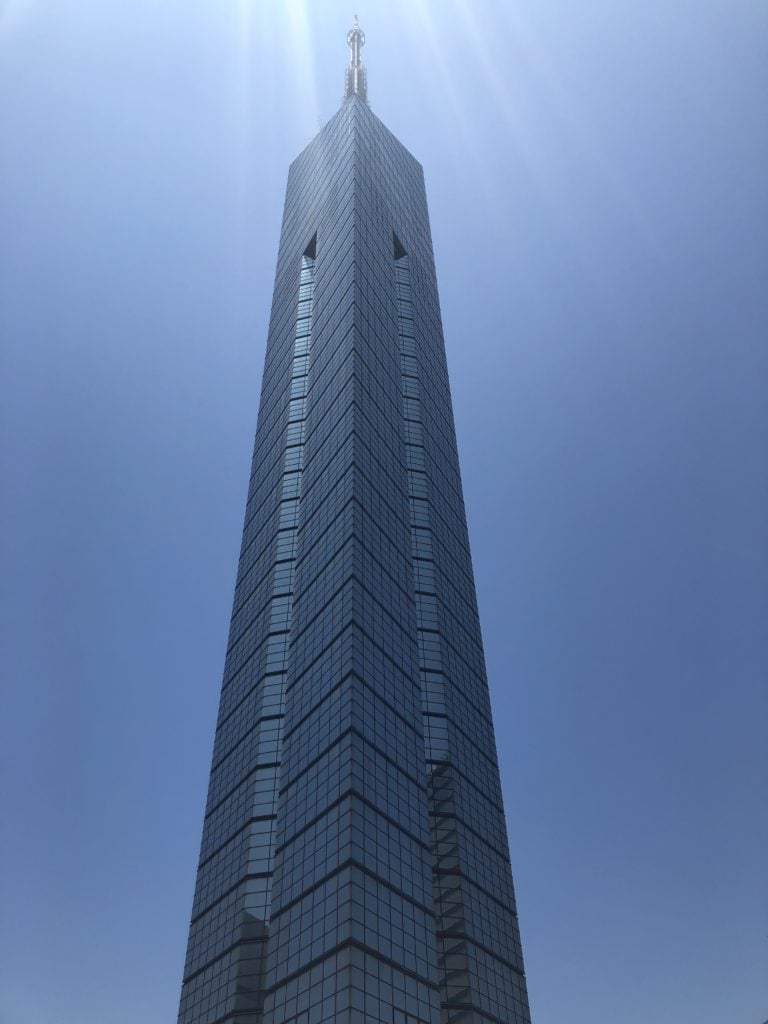
Entering Fukuoka Tower on the first floor you will purchase your tickets and have the chance to look at souvenirs or even grab something quick to eat. You’ll then get on one of the elevators which will take you to the fifth-floor observation deck that is 123 meters above the ground!
From there you will have an outstanding panoramic view of Fukuoka City including the sights of Mt. Atago, the Muromi River, Nokonoshima Island, Shikanoshima Island, Uminonakamichi Seaside Park, Hakata Bay, and many more iconic destinations in Fukuoka City.
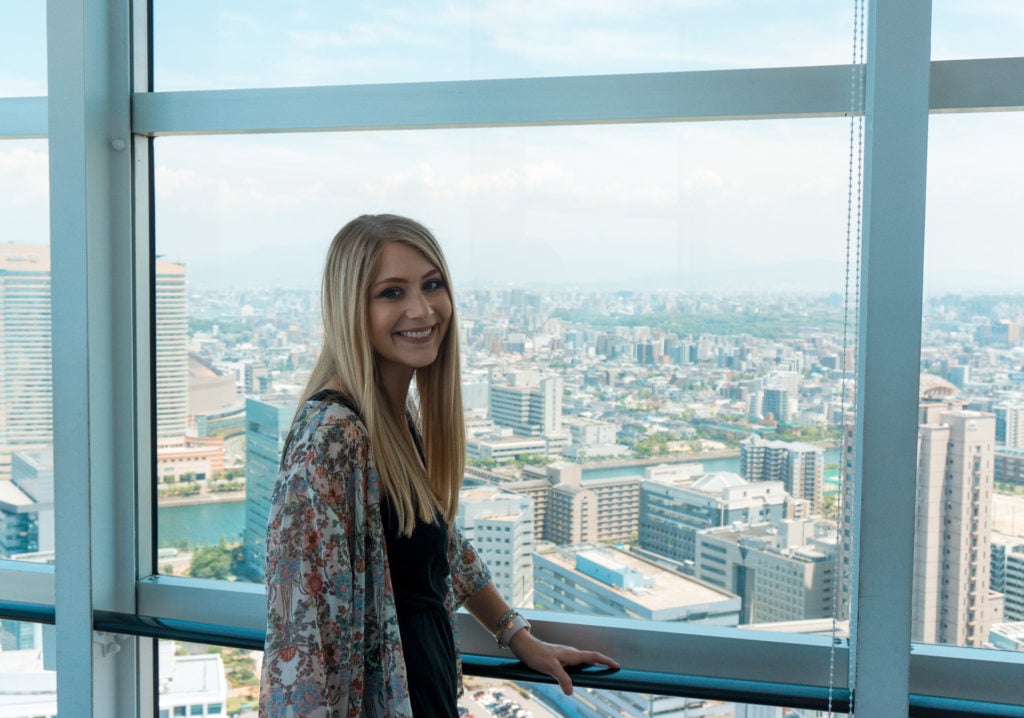
There are many fun things to do on the tower’s top floor such as creating a pressed souvenir coin, stamping your ticket or a piece of paper with the Fukuoka Tower logo, and trying to keep your balance on this bowl of hot ramen!
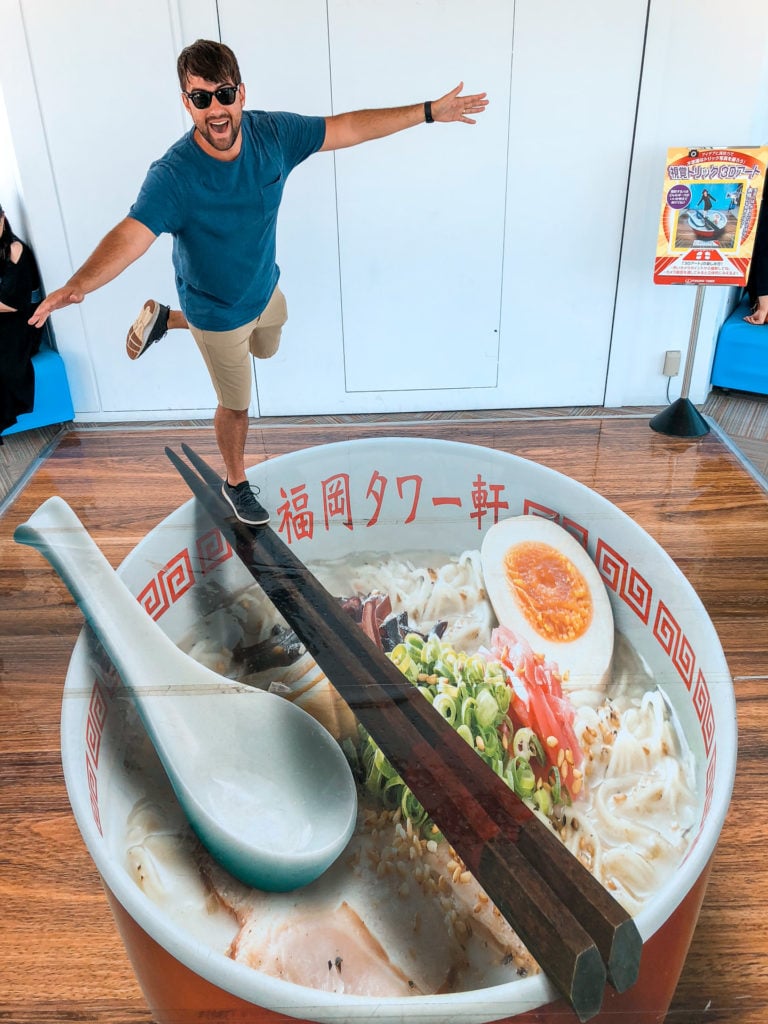
Walking down to the fourth floor there is a dining area called the Sky Lounge which has terrific views of the city from every table! On the third floor, you can take the elevator back down to the first floor but don’t go without seeing the Lover’s Sanctuary.
Iconic spots on this floor include the wall where “love” is written in 100 different languages and the hall of love locks which you can purchase one of your own for ¥1,000 and place it in Fukuoka Tower for a lasting memory!
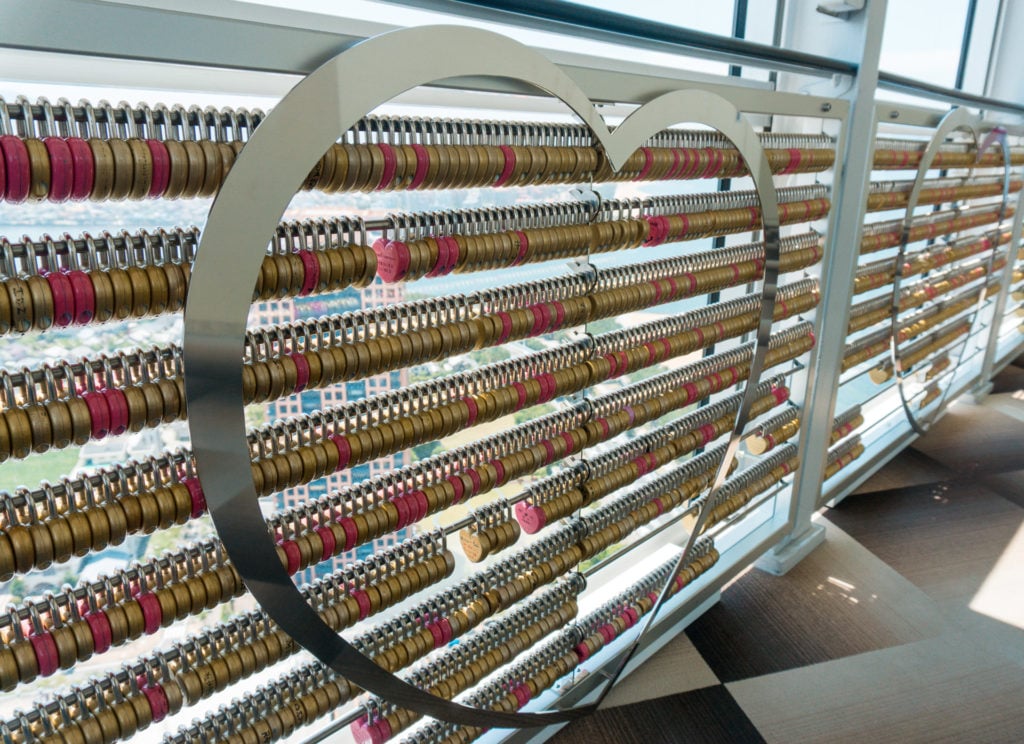
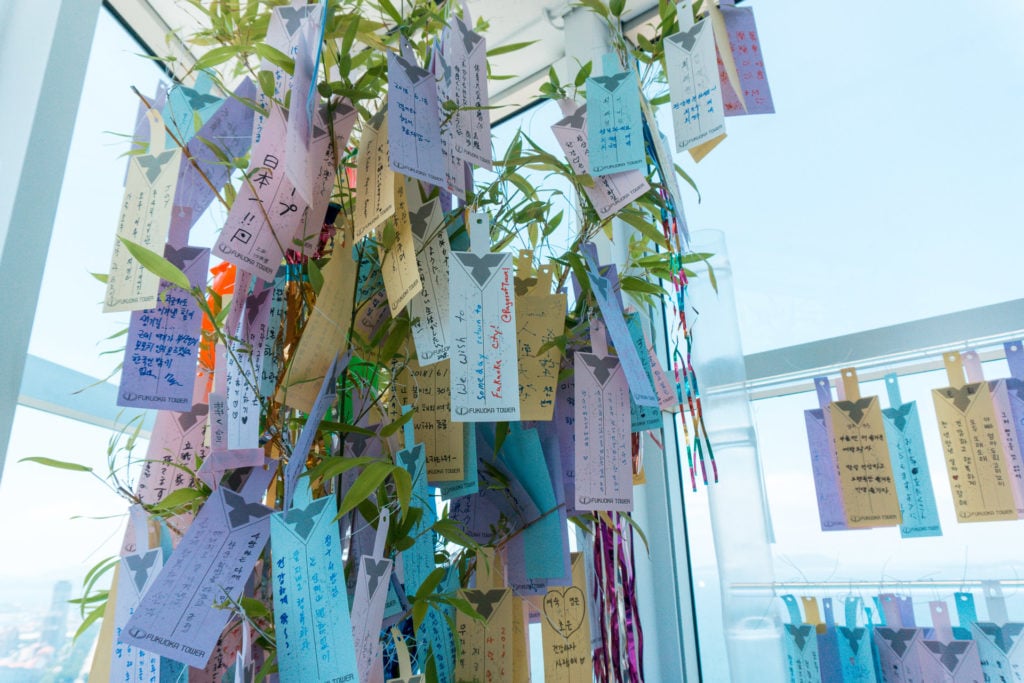

Address: 2-3-26, Momochi-hama, Sawara-ku, Fukuoka // MAP
Visit One of Fukuoka’s Oldest Shrines, Kushida Shrine
Kushida Shrine was founded in 757 and is considered one of the oldest shrines in Fukuoka City. This shrine hosts a few different deities but there are three main deities including Amaterasu,

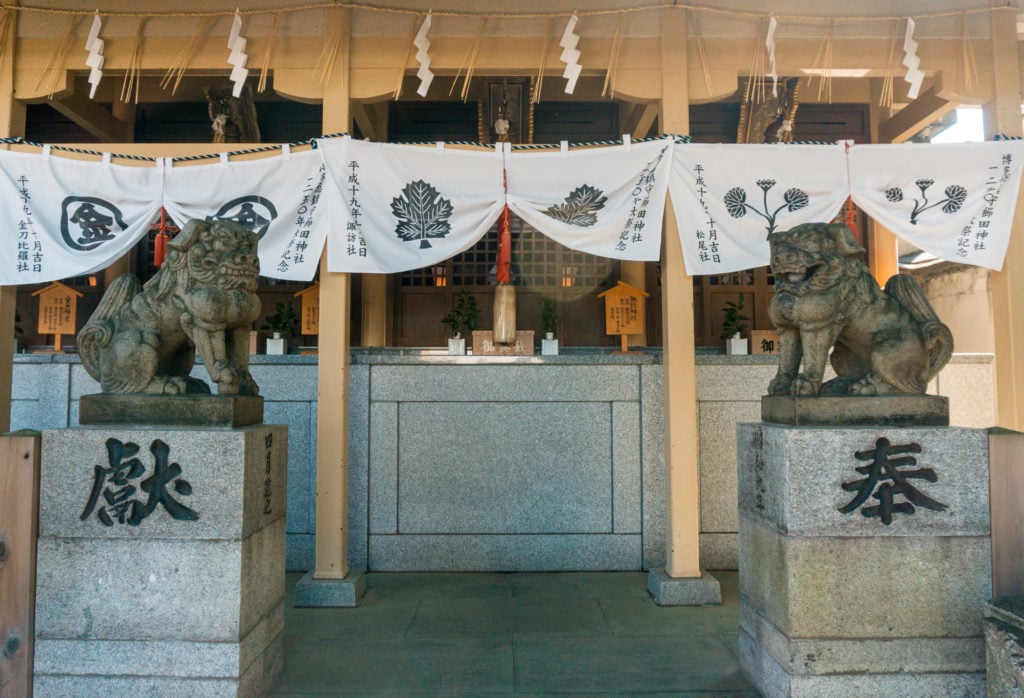
Kushida Shrine has another importance as well. Each year from early to mid-July Kushida Shrine is the host of Hakata Gion Yamakasa, the biggest matsuri (festival) held in Fukuoka.
On the last day of the festival seven different teams representing the seven different wards of Fukuoka City race carrying kakiyama floats. There are also large decorative kazariyama floats that are displayed around the city, including one at Kushida Shrine. The permanent floats that are featured around the city stand 10 meters tall and weigh roughly 2 tons!
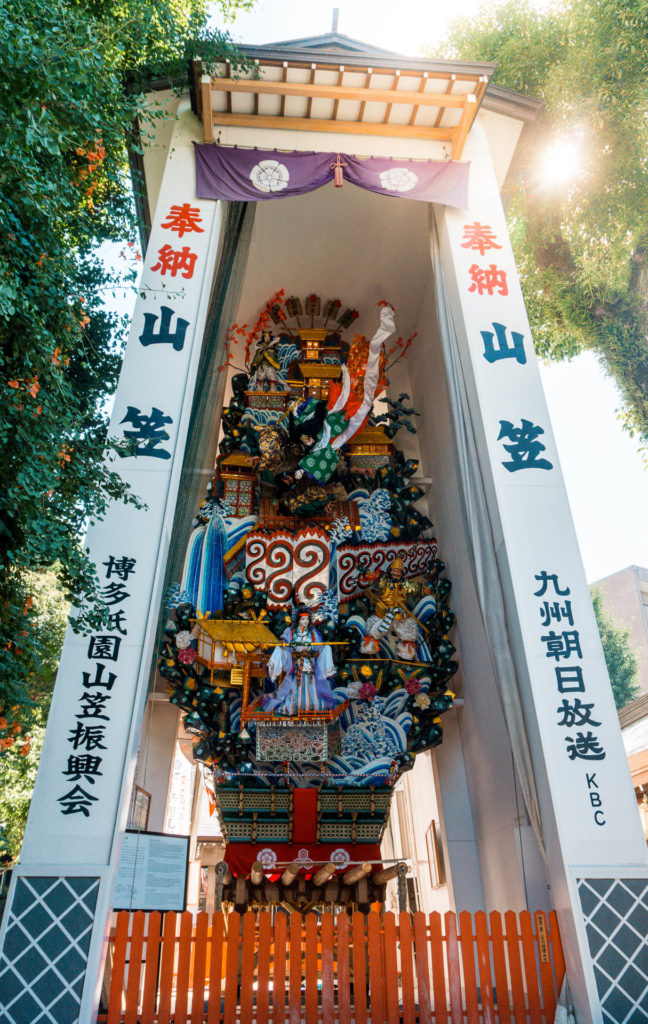
Location: 1-41, Kamikawabata-machi, Hakata-ku, Fukuoka // MAP
Learn About Fukuoka Festivals at Hakata Machiya Folk Museum
Hakata Machiya Folk Museum is the perfect place to go and learn about the many annual matsuri (festivals) that happen in Fukuoka, especially if you aren’t able to visit Fukuoka during one of the festival seasons.

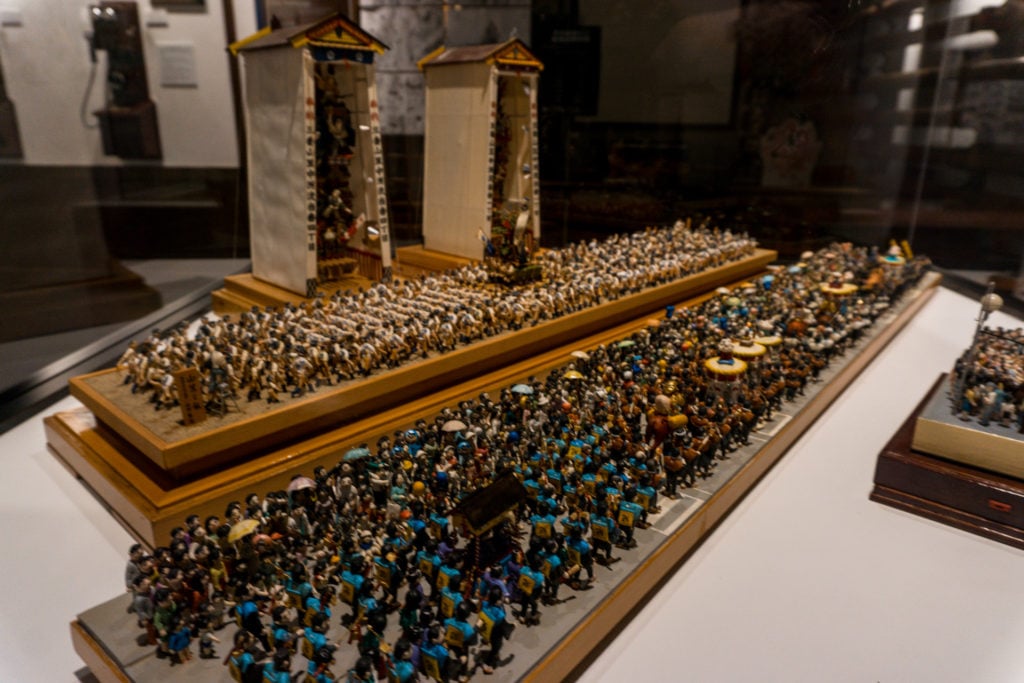
Hakata Gion Yamakasa is the matsuri we learned the most about at Hakata Machiya Folk Museum as it was coming up in just a few short weeks. The museum has an informational video about the festival that is incredibly fascinating. We watched the documentary in awe as it depicted the process of building the floats by hand and with primitive tools.
As we mentioned, Hakata Gion Yamakasa is a tradition that takes place every July, but those involved are preparing for the festival long before that. The floats are made without any nails, only wood and rope. There are weeks of preparation, practice runs, blessings, and then the big day!
On the morning of the Oi-Yama race, many in the city do not sleep, as they are anxiously awaiting the start of the race. On the morning of matsuri, at 4:59am the race begins to see which ward will have the honor of taking first place.
Location: 6-10, Reisen-machi, Hakata-ku, Fukuoka // MAP
See the Large Wood Buddha at Tochoji Temple
Tochoji Temple may be in the city but once you enter the temple gates you’ll be immediately surrounded by tranquility. On the temple grounds, you can gaze upon a five-story pagoda that stands glimmering in the sun.
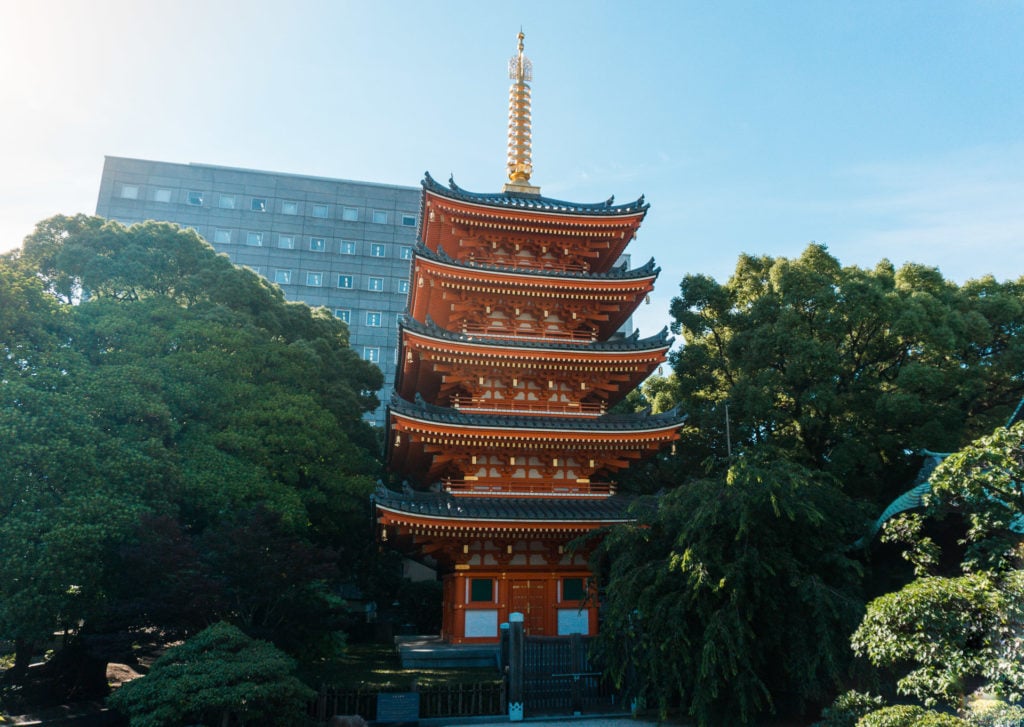
On the second floor of the temple, you will be marveled by a large wooden statue of Buddha that is seated on a pedestal, it is the largest of its kind in Japan. We spent a few minutes simply smelling the incense, listening to the slight creaking of the floorboards, and gazing upon the statue – taking it all in.
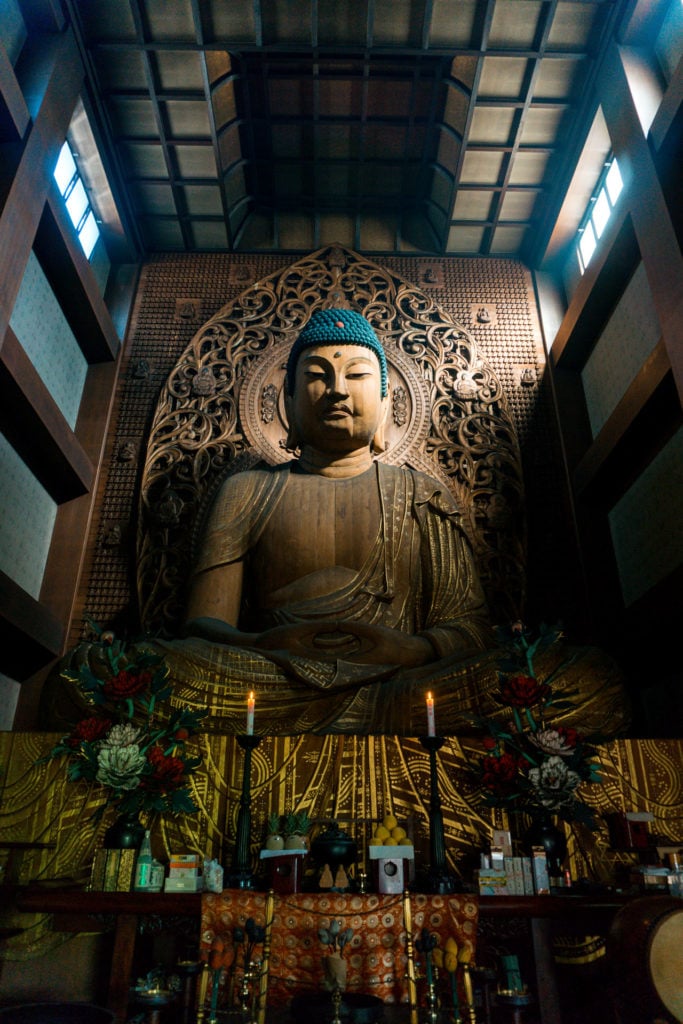
After paying respect, you can walk through a room behind the displayed Buddha and see the artistic depictions of the realms of hell. After seeing the viewing you will then go into a pitch-black tunnel where you will try to feel around to find a metal ring situated on the wall (about the size of a coaster) which will lead you safely to the other side.
After making it through the dark tunnel, you will be greeted by more artistic depictions, but this time of heaven. The experience is rather unique and at times chilling.
*Disclaimer: You are typically not allowed to take photos of the wooden Buddha at Tochoji Temple. We were granted permission due to our partnership with Welcome Fukuoka.
Address: 2-4, Gokusho-machi, Hakata-ku, Fukuoka // MAP
Enjoy the Art of Tea at YOROZU
Yorozu shares the heartfelt history behind the art of tea and a way to experience tea with all of your senses. When you walk in you are greeted by a sensational aroma of tea and the beauty of the cherry tree table that welcomes you to sit at it around the stove.
The stove you see here is not just a place to boil water and make tea, its meaning goes much deeper than that. In days prior, many family homes had stoves as such. Families would sit around the stove cooking, eating, and enjoying one another’s company. The owner of Yorozu, Tokubuchi-san, wants to bring that idea of family time or
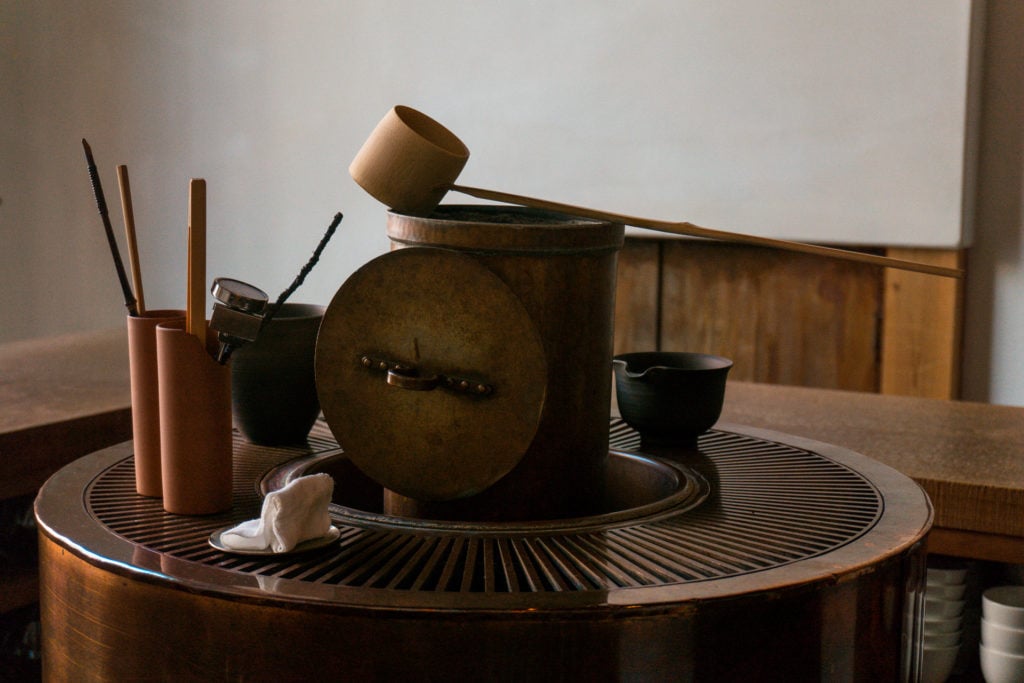
Since it was quite warm the day we visited, the first tea we tried was a cold brew green tea that was slowly dripped over 8 hours. It has a light and refreshing flavor that is perfect for summer.
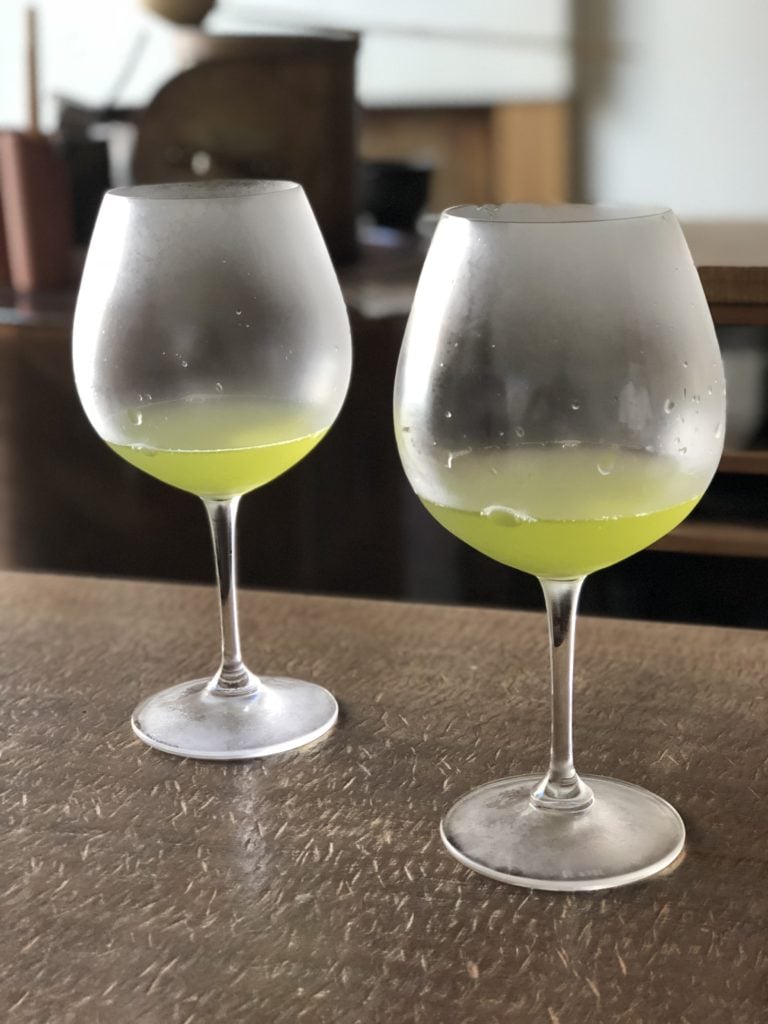
The next course of tea we tried was all brewed with the same tea leaves. However, each serving had a different unique flavor due to changes in long it was brewed as well as varying temperatures. We noticed the taste shifted slightly with each change making it have a deeper flavor. With each tea that was prepared and poured, we noticed how methodical the steps were and became mesmerized by the process as if we were watching a piece of artwork come to life.
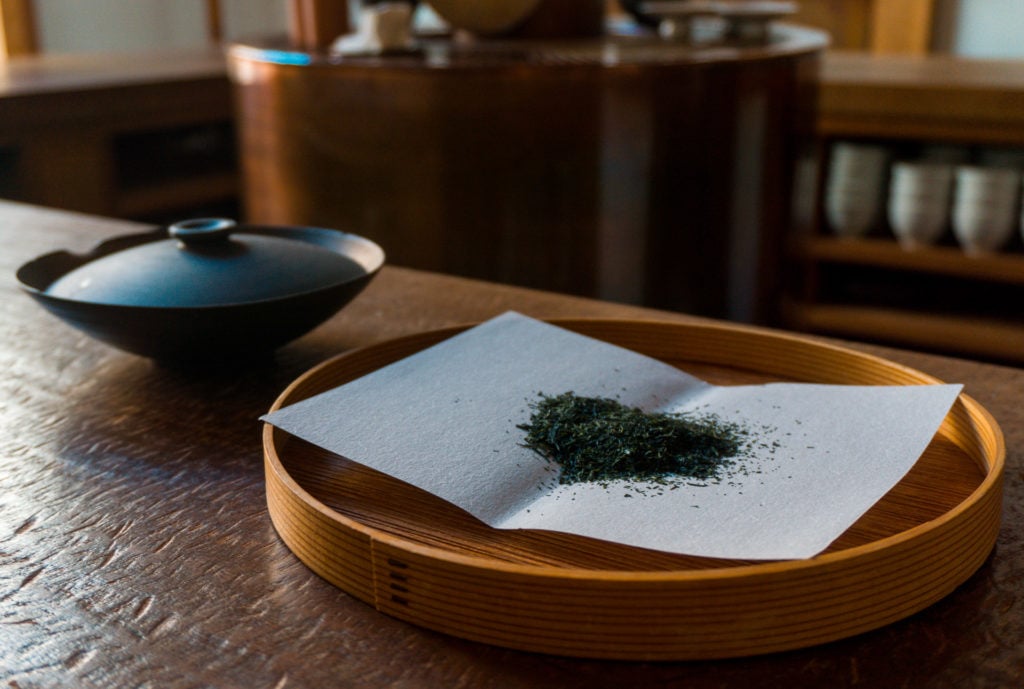
The first tea we had was brewed at 35 degrees Celsius, it is known as Hatsuhana (first flower). The 2nd tea was brewed at 50 degrees Celsius, the 3rd tea was at 80 degrees Celsius, and finally, the 4th at 90 degrees Celsius – here the flavor reached its peak and was rich and robust.
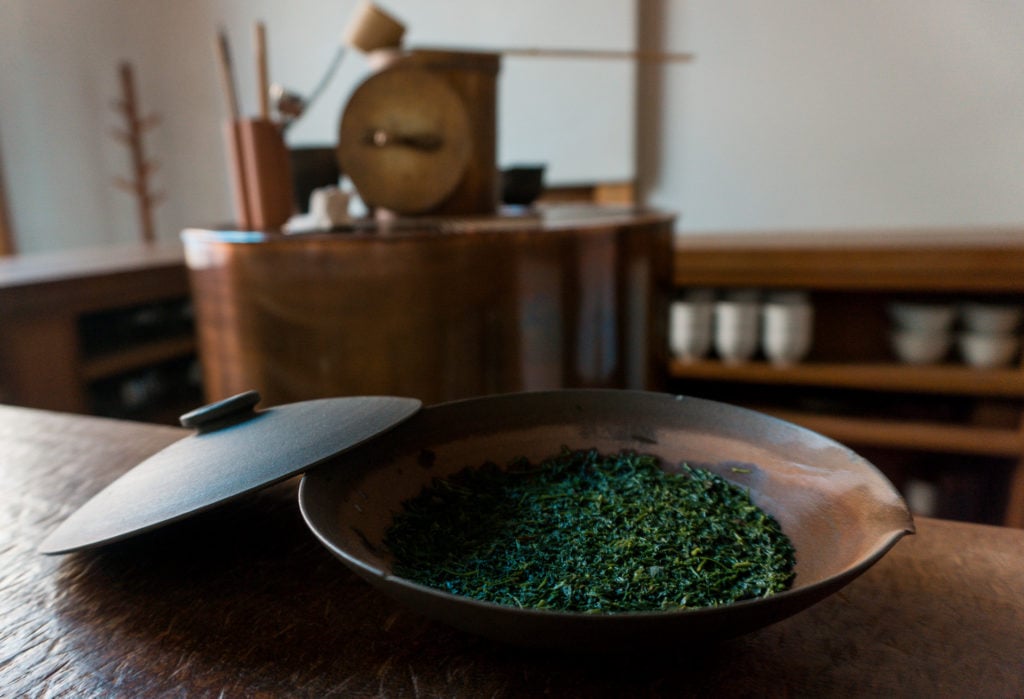
Tokubuchi-san talked about how the brewing process of tea can be compared to relationships. When first meeting someone the relationship may lack the warmth of a true friendship and the “flavor” is mild, but as you get to know someone the relationship becomes warmer, flavor deeper, and even more inviting.
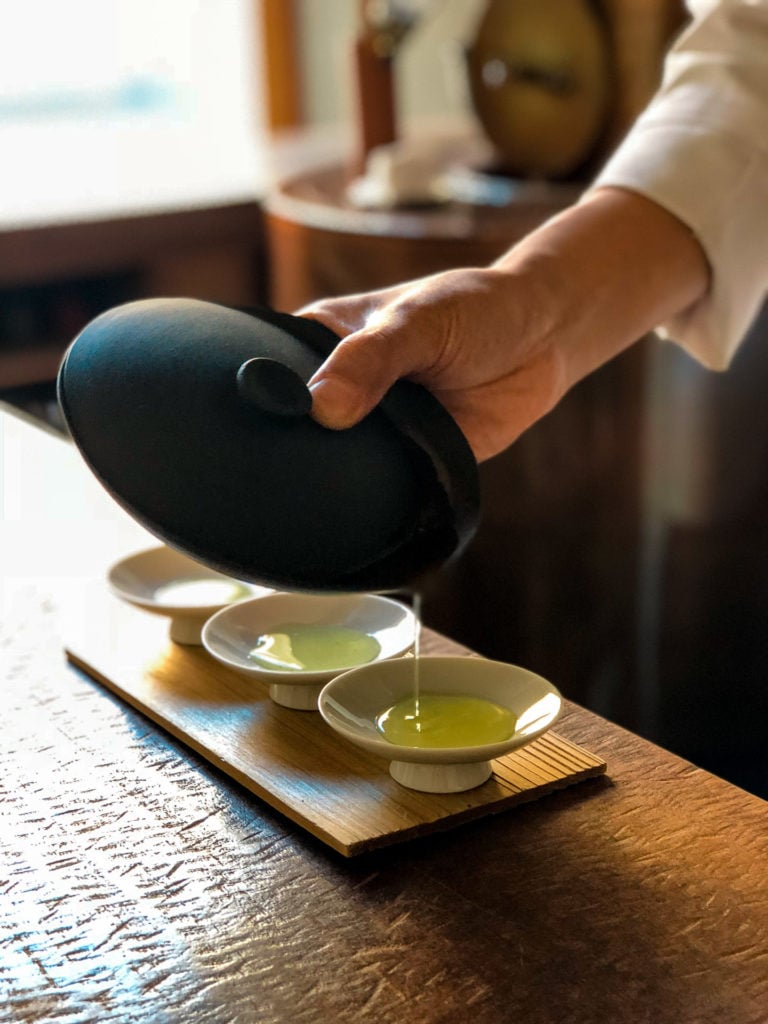
At the end of our tea tasting, we tried some delicious wagashi, which are beautifully crafted traditional Japanese-style sweets. Each treat is from well-known confectionaries in Japan, make with local seasonal ingredients. Logan had the Ajisai (hydrangea) shaped wagashi and I tried the Manju cake. Both were meticulously plated and served with our final cup of tea.
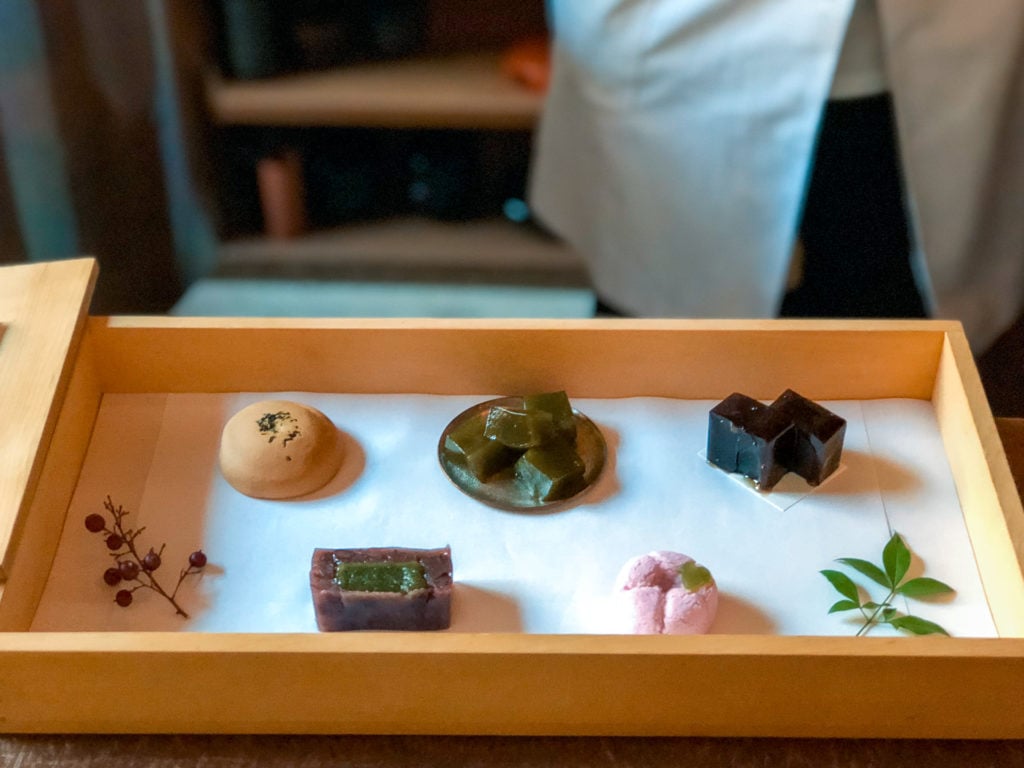
The second treat course included: a date with walnut and nutmeg for Logan and a matcha-dusted tofu chocolate for me. The tofu was so rich and creamy, I was surprised to learn that it contained only half the sugar that you’d find in normal chocolate.
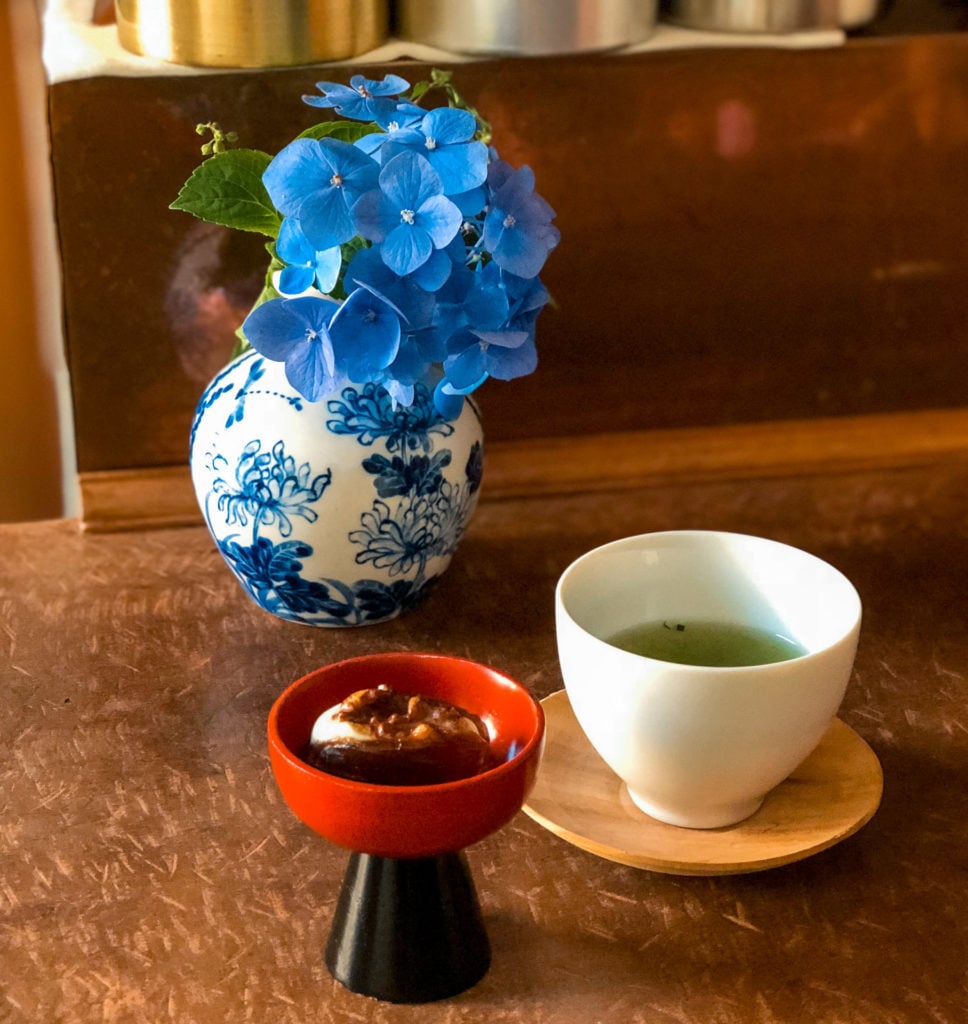
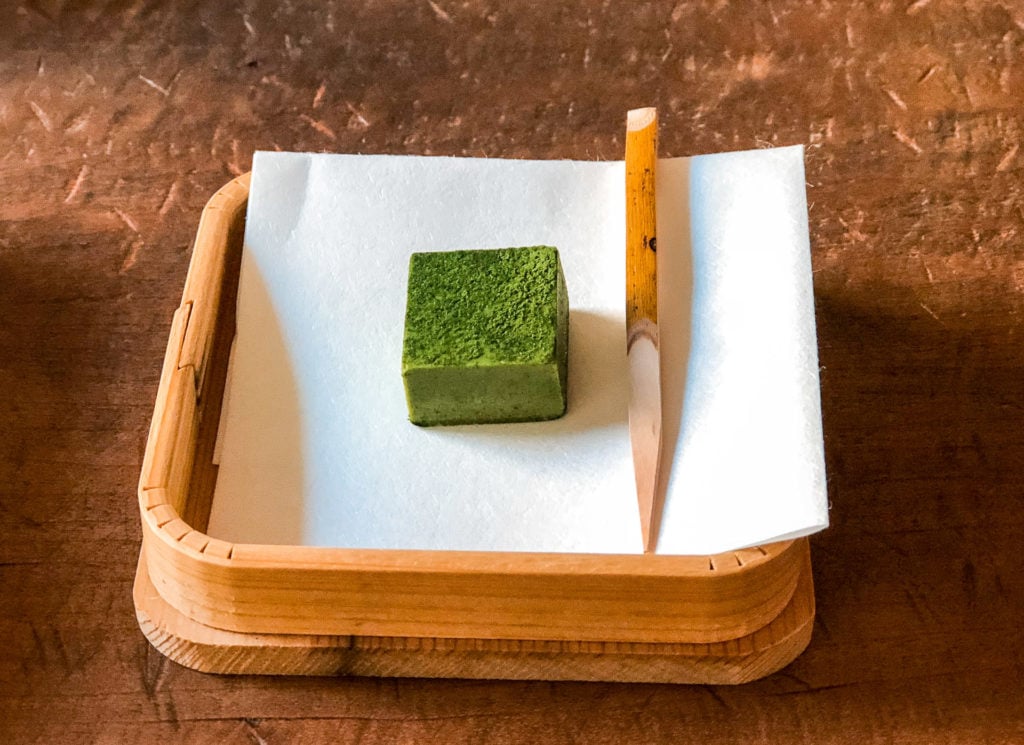
For the final course, Tokubuchi-san took the tea leaves used to brew our tea and added a bit of ponzu sauce for us to eat. It was a nice touch to have a bit of savory and salty flavor after all the sweets and as well as enjoy our tea in a new way, one last time!
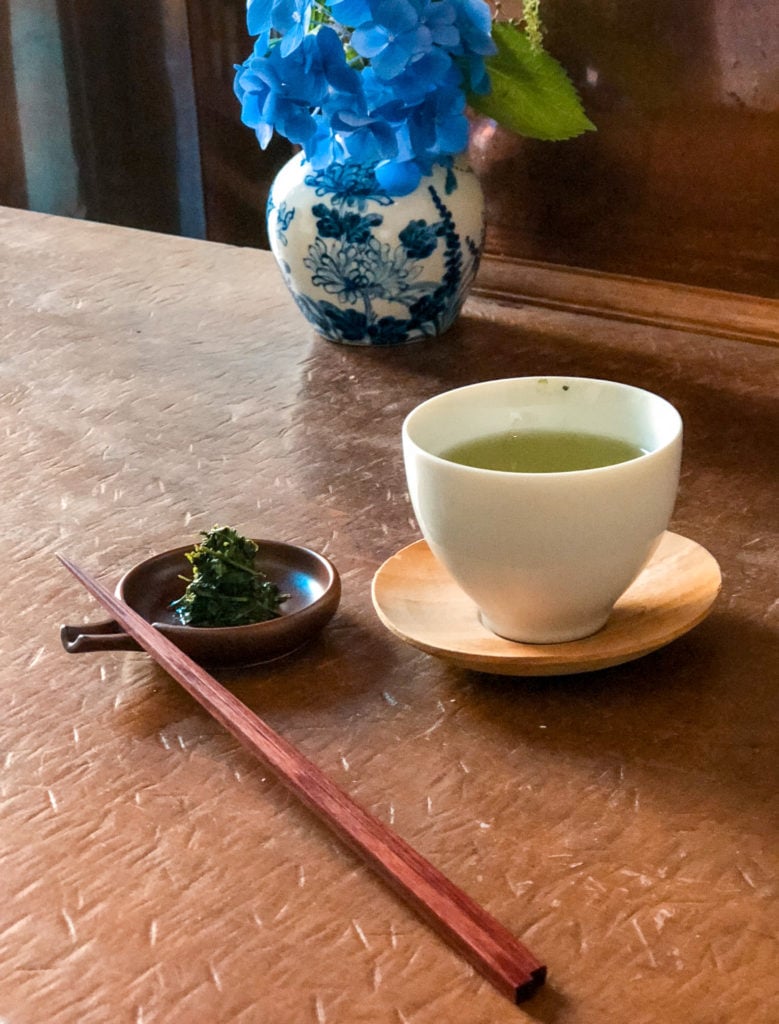
Yorozu takes you to a place you hope you experience if only for a moment when visiting Japan. The meticulous detail and craft of making tea and beverages are the perfect marriage between traditional Japanese tea making and modern elegance.
Whether you are a tea connoisseur, a family looking to experience something unique, or someone wanting to indulge in a cocktail and stoveside conversation, Yorozu is an experience that will leave you entranced until the last drop.
Address: Fukuoka Prefecture, Fukuoka, Chuo-ku, Akasaka 2-3-32 Akasaka MOKUZO 1F // MAP
Fukuoka Itinerary Guideline
If you only have two days in Fukuoka here is a general Fukuoka itinerary that you can follow to make the most of your time in Fukuoka!
Fukuoka Itinerary: Day One
- Start your morning at Uminonakamichi Seaside Park.
- Rent bicycles at Shikashima Cycle to explore the Shikanoshima Peninsula.
- Travel to the Shikanoshima Bridge and beach (via bicycle)
- Visit Shikaumi Shrine (via bicycle)
- Have lunch at Nakanishi Shokudo
- Return bikes and grab a refreshing drink at Shikanshima Cycle Cafe!
- Check-in to your hotel (We loved Hotel Il Palazzo and Grand Hyatt Fukuoka!)
- Go shopping at Canal City Hakata and stay for the latest Aqua Panorama Show.
- Dinner at Hakata Izumi or Ramen Stadium
- Late-night drinks and snacks at the Yatai Food Stalls
Fukuoka Itinerary: Day Two
- Wake up early and grab breakfast at your hotel.
- Take the ferry to Nokonoshima Island (You’ll probably spend a few hours here!).
- Return on the ferry to the main city.
- Take the elevator up to the top of Fukuoka Tower – the views of the city are incredible!
- Lunch at Karonouron (the best udon we’ve ever had! Get #1 with burdock root).
- Visit Kushida Shrine
- Learn about the history of Fukuoka’s festivals and more at Hakata Machiya Folk Museum
- Visit Tochoji Temple
- Experience Japanese tea at Yorozu – Green Tea Bar
- Dinner at Hanamidori Mizutaki Hot Pot
Fukuoka quickly became one of our top cities in Japan, and we’ve now visited four times! We hope this Fukuoka itinerary has inspired you to head south on your trip to the Kyushu region and visit Fukuoka!
We want to thank Fukuoka CVB for inviting us as their guests.

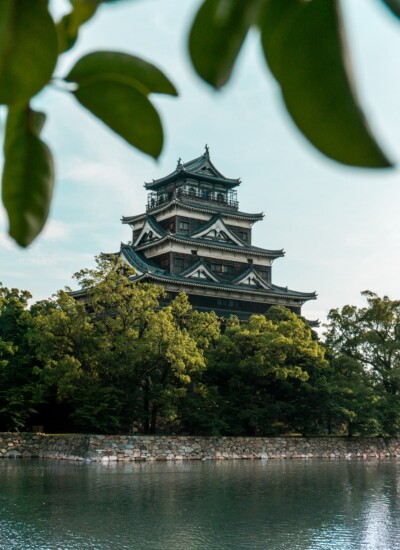
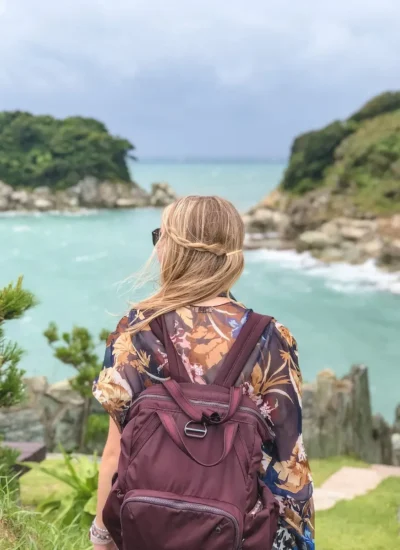

Comments & Reviews
Tee-san says
Is the Hotel II Pallazo closed down already? Unable to see the room rates at all !
Kallsy says
Hi! I just checked and it appears they’ve temporarily closed for renovations. Another hotel I would recommend is the Grand Hyatt Fukuoka! It is in a great location and has lovely rooms.